
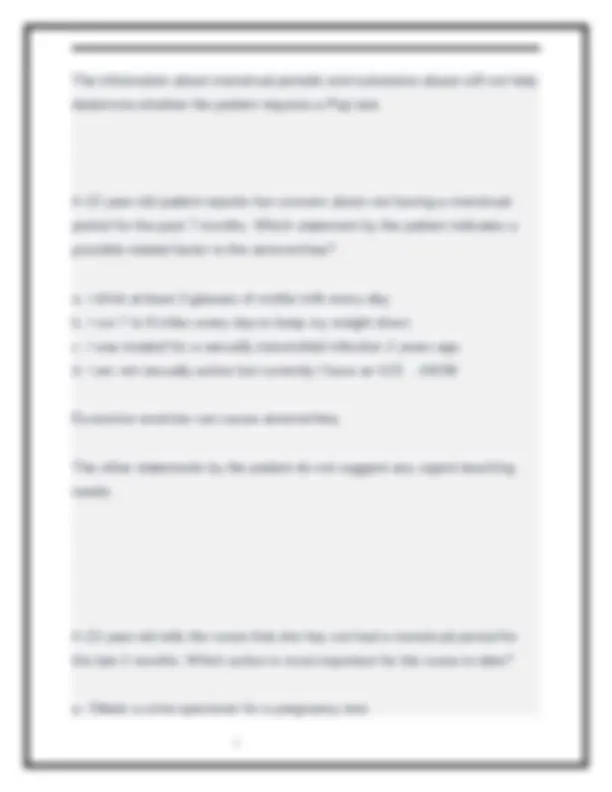
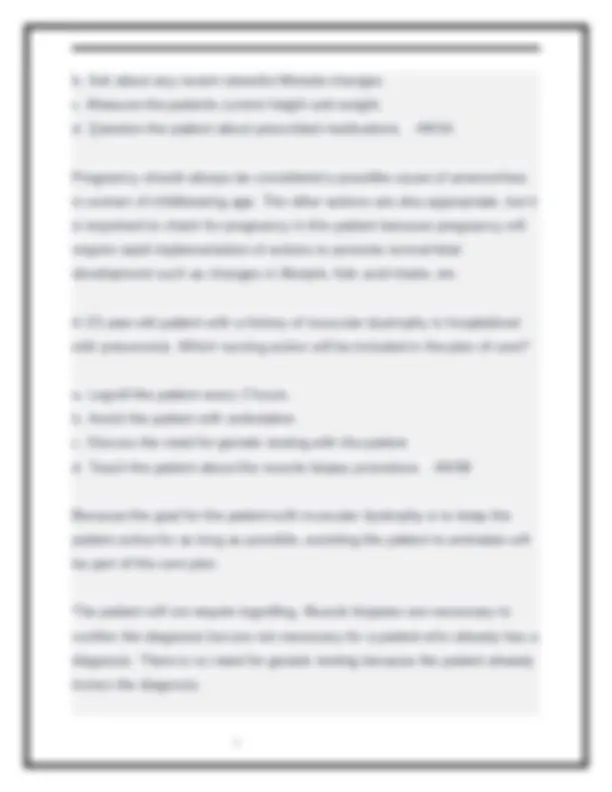
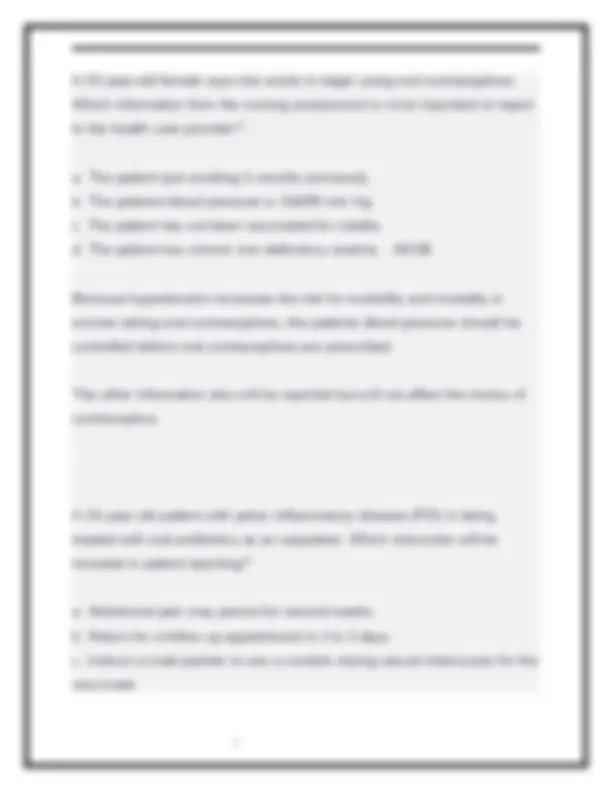
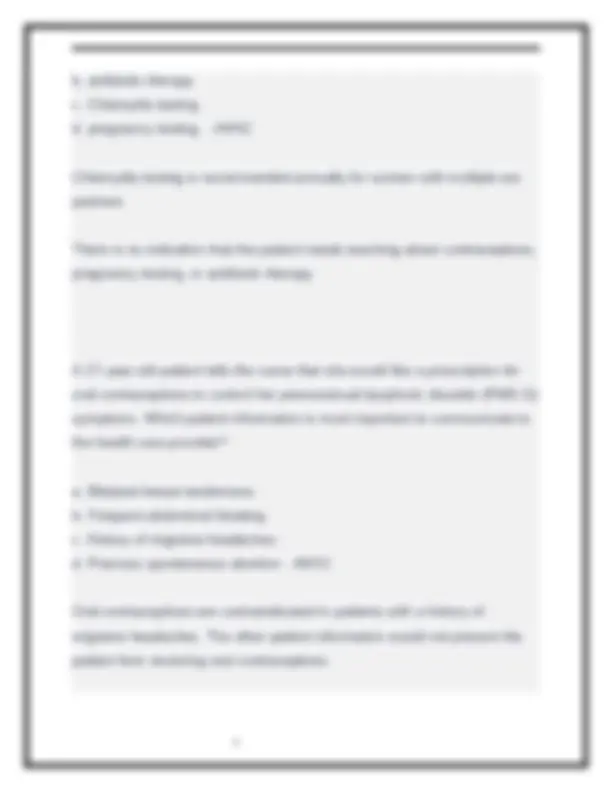
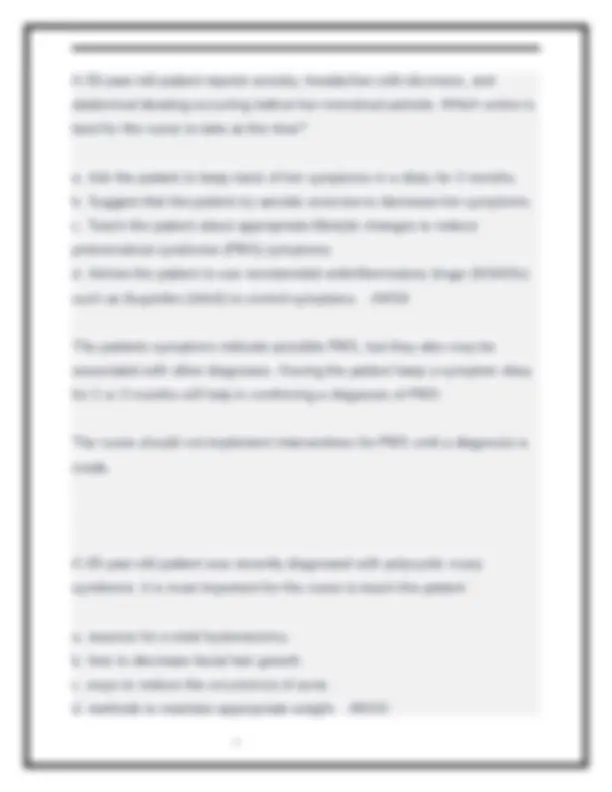
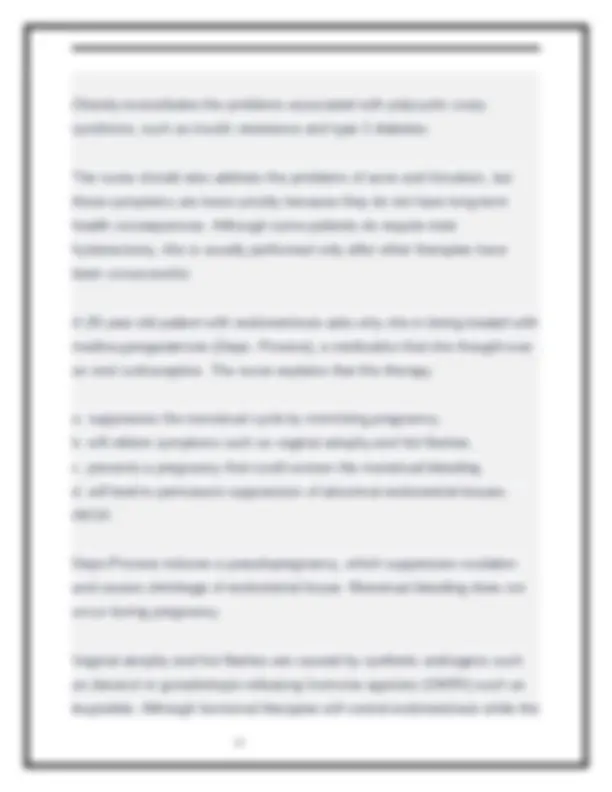
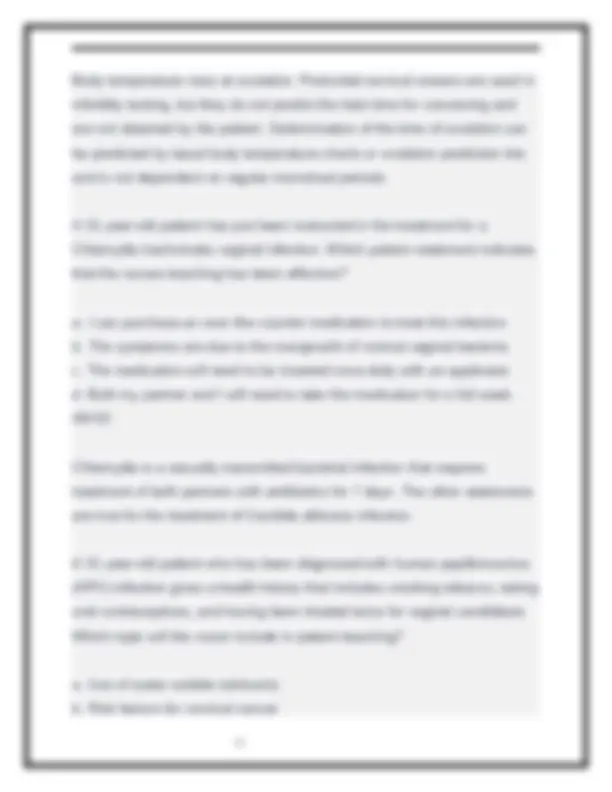
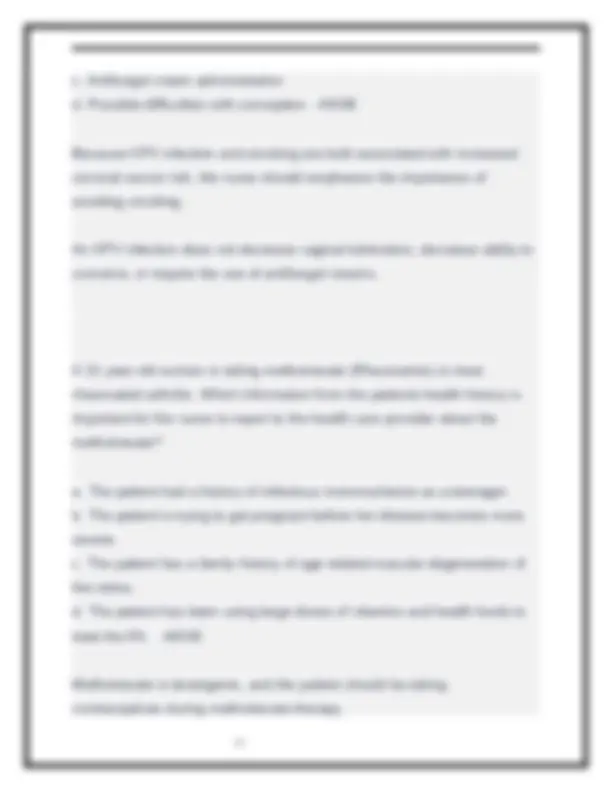
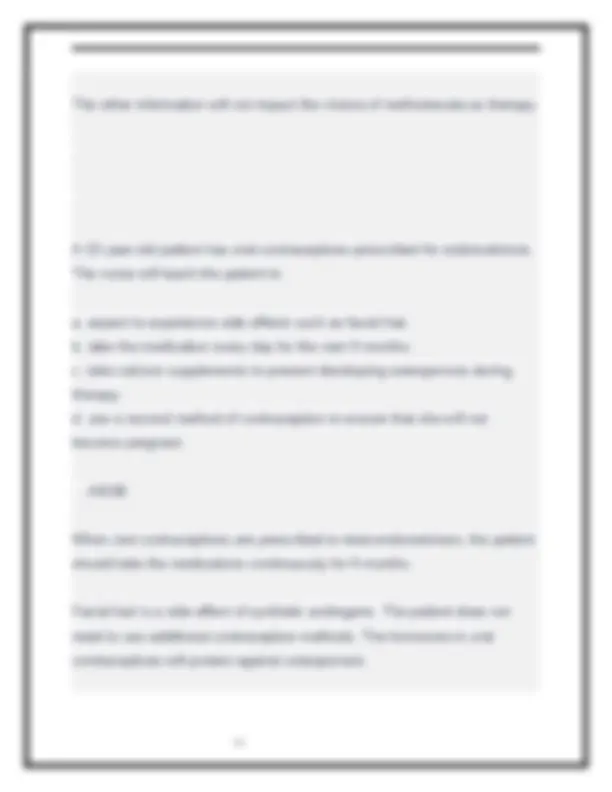
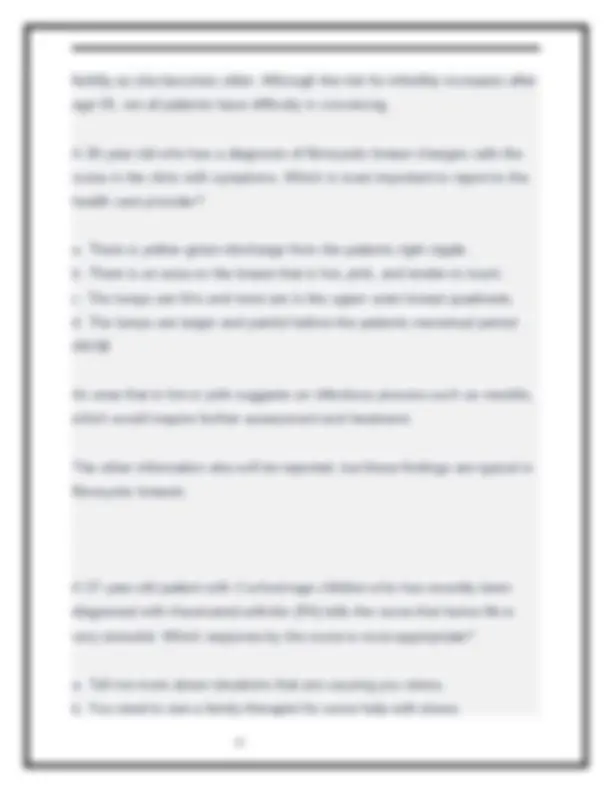
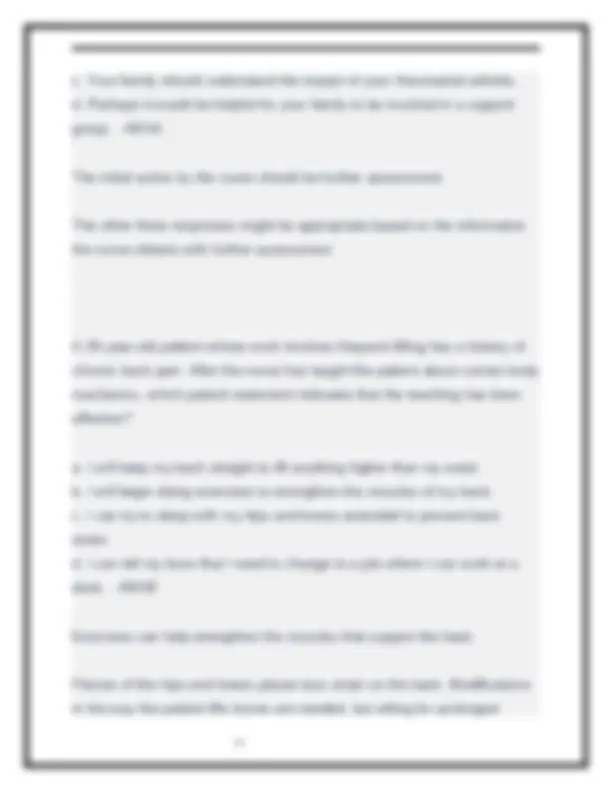
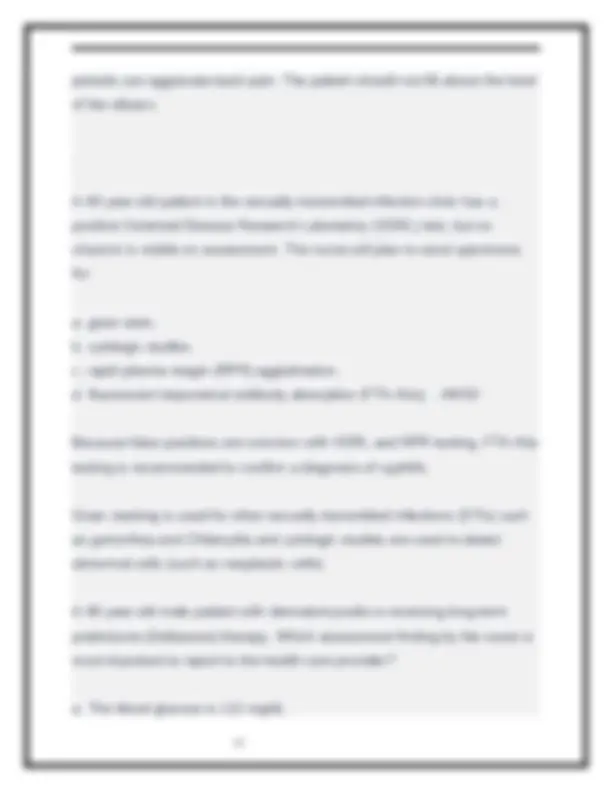
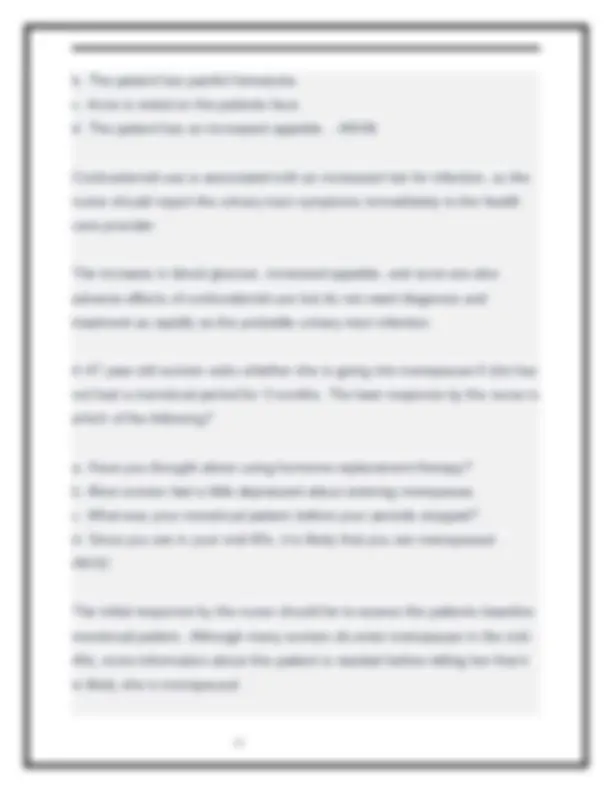
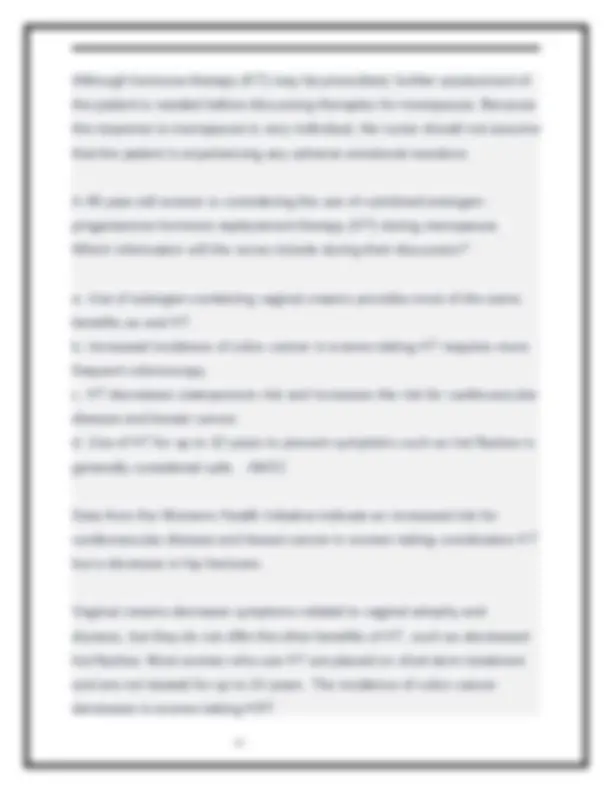
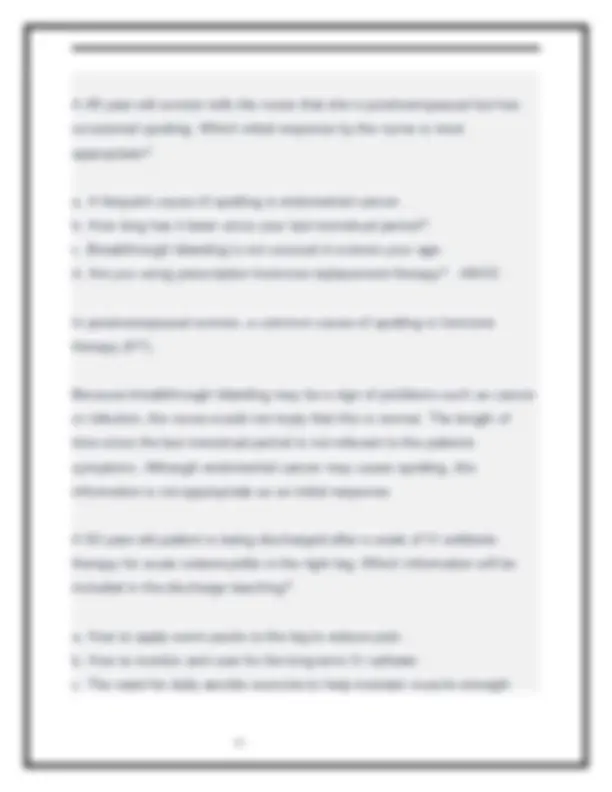
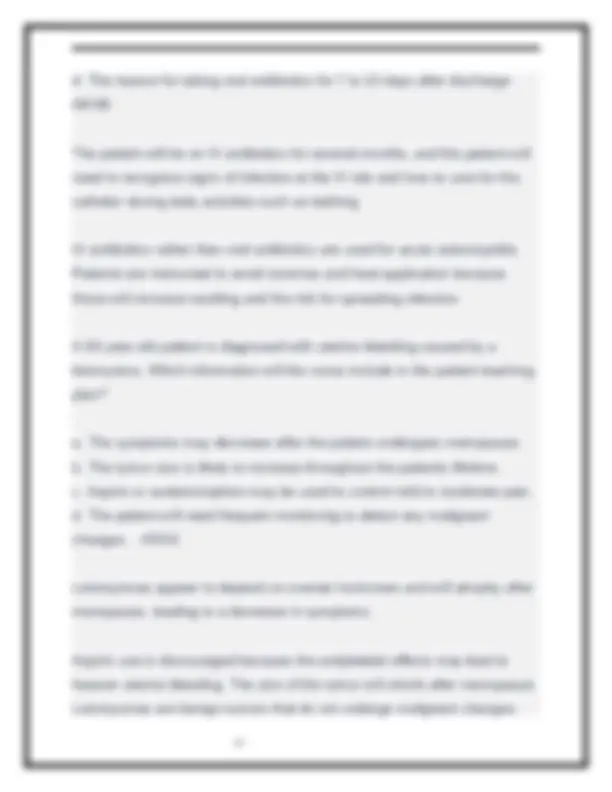
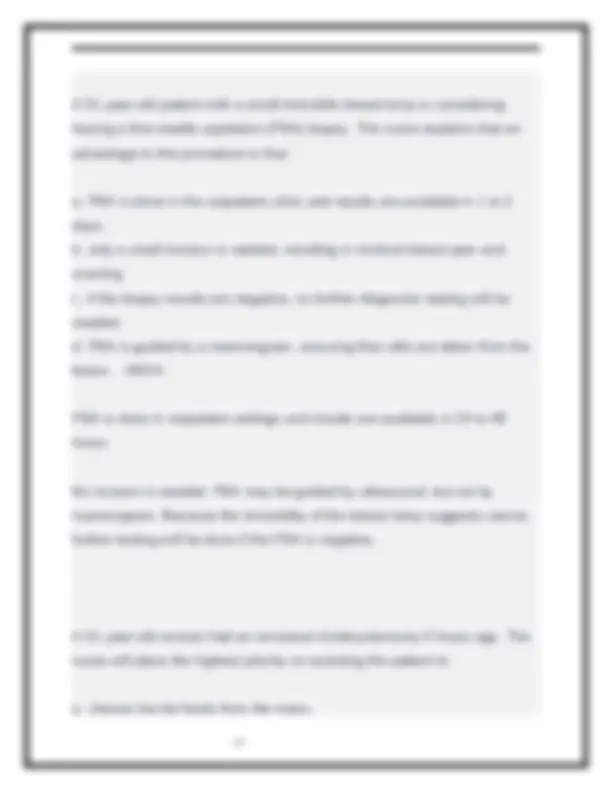
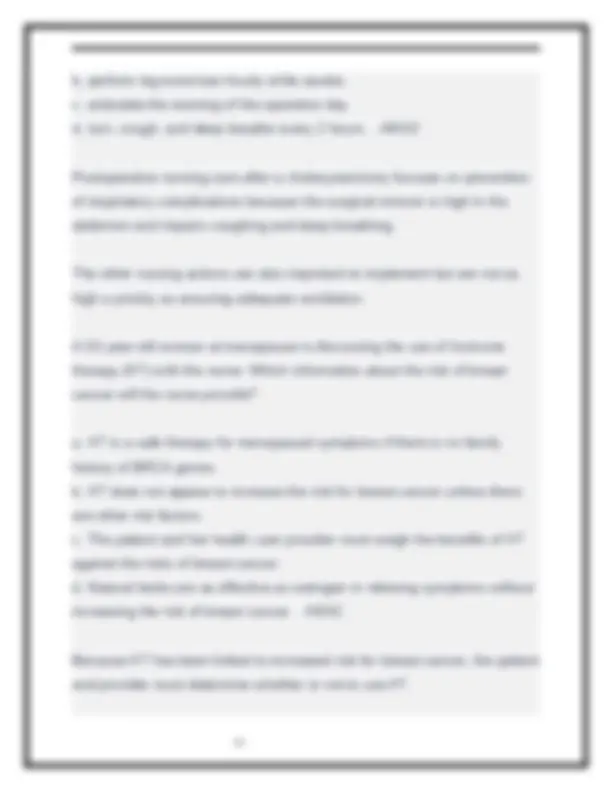
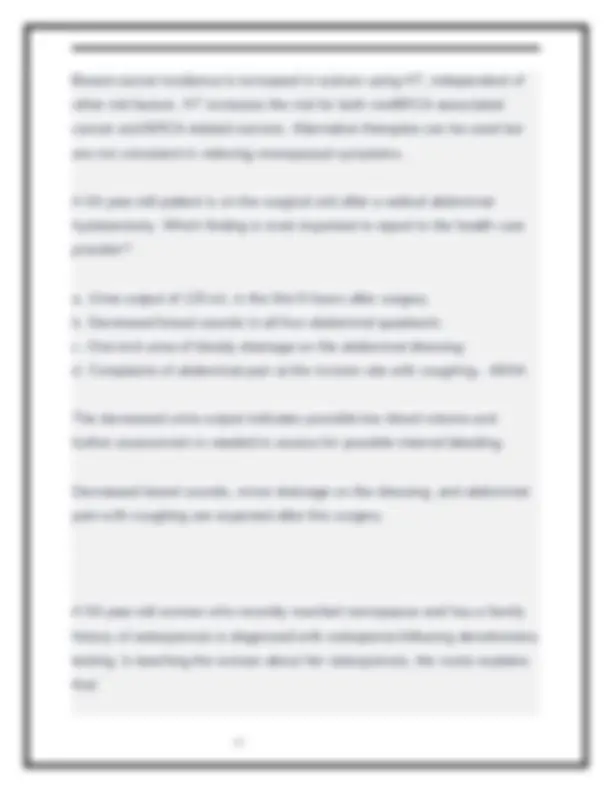
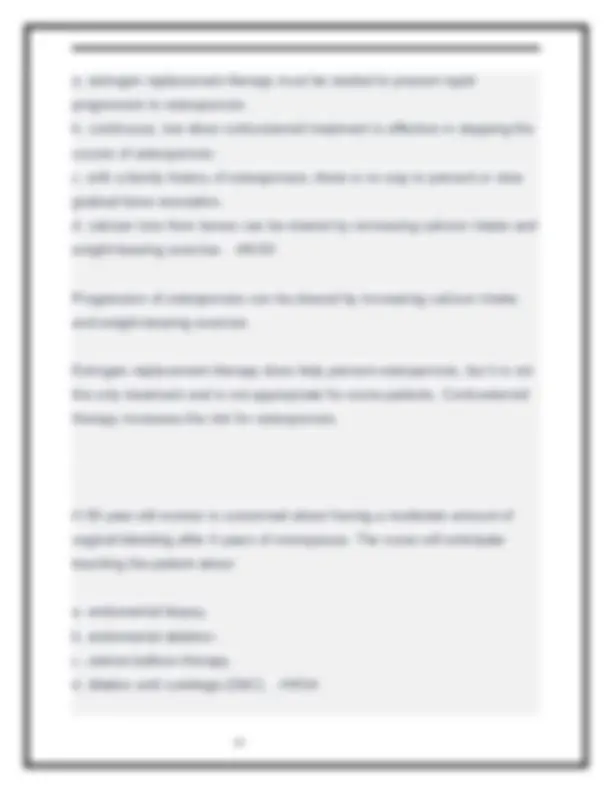
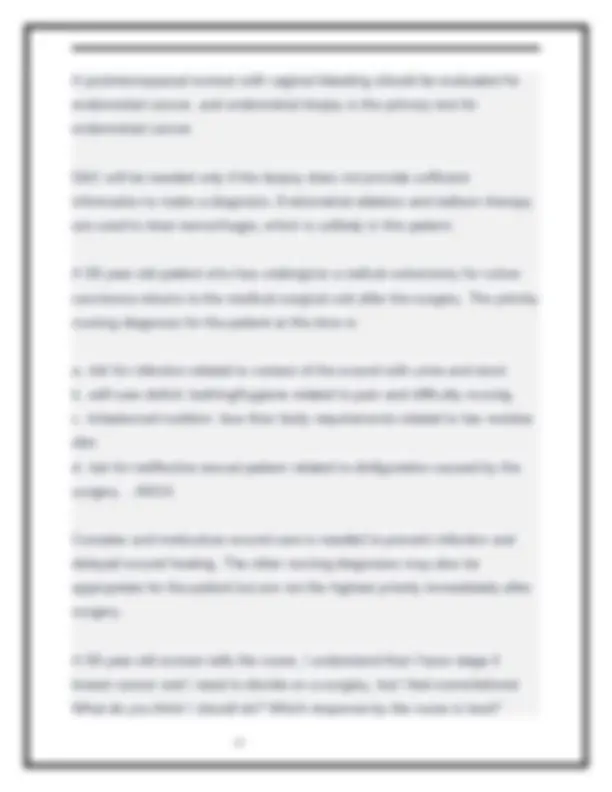
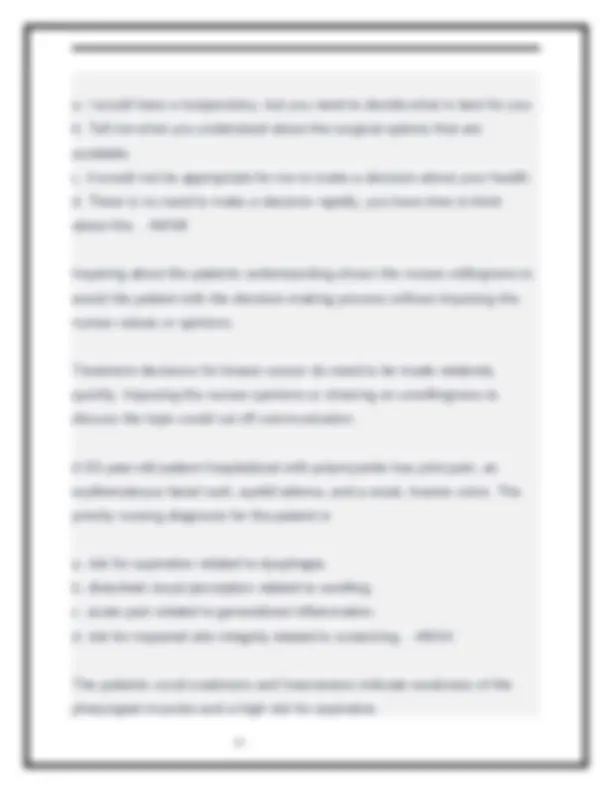
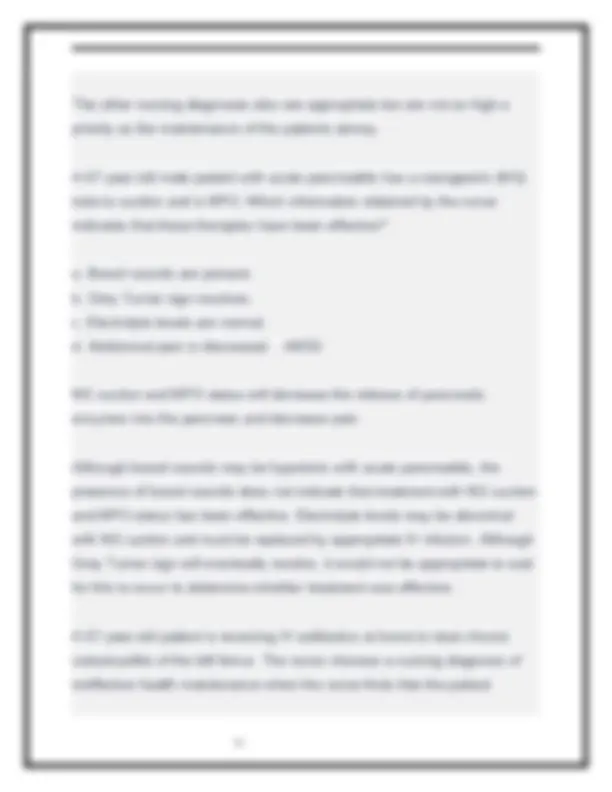
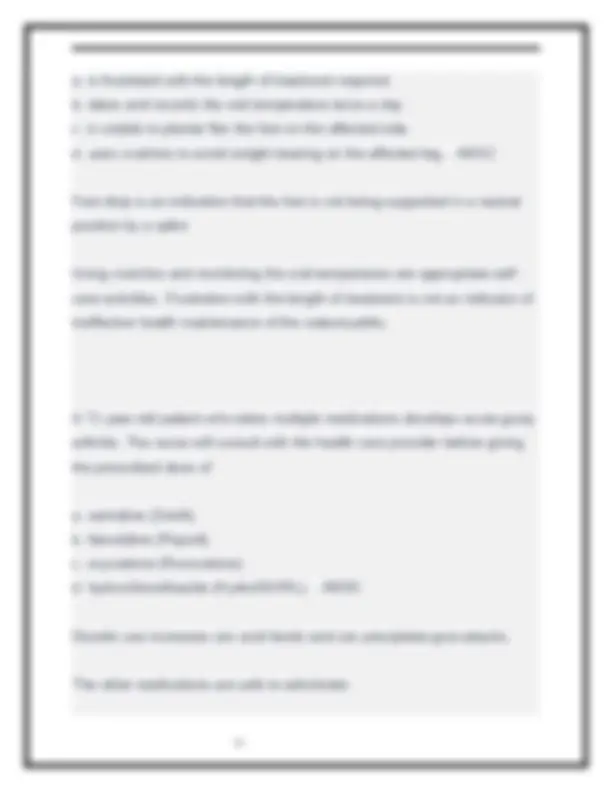
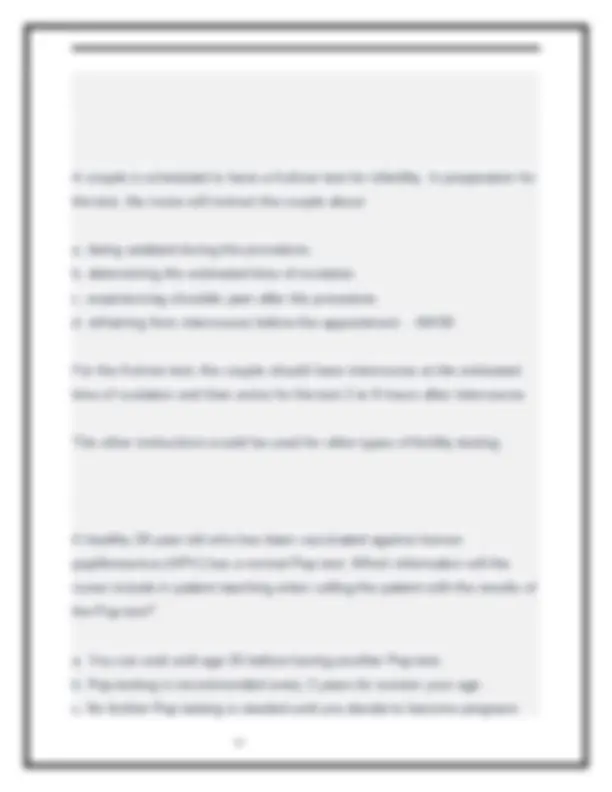
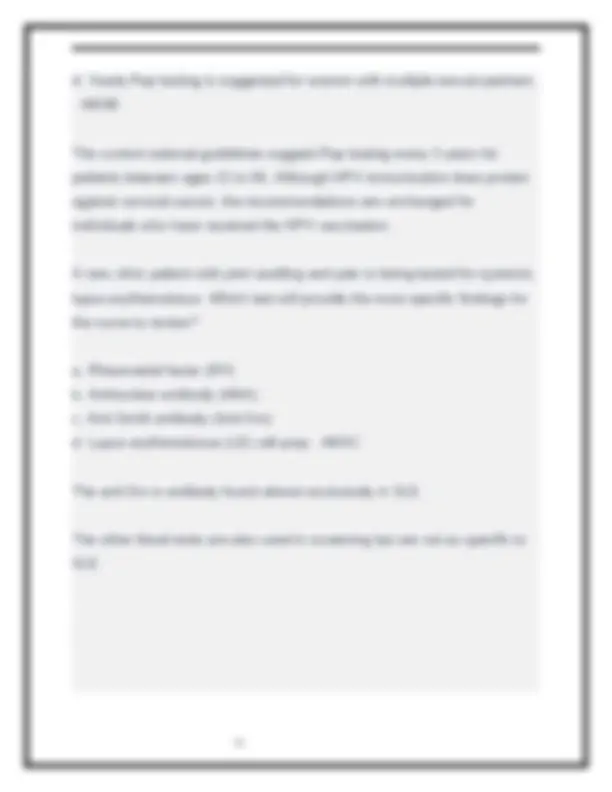
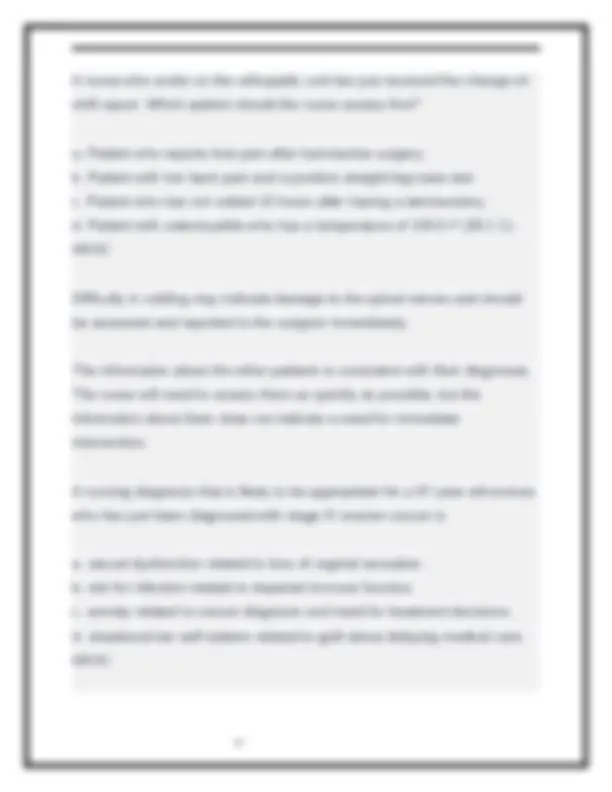
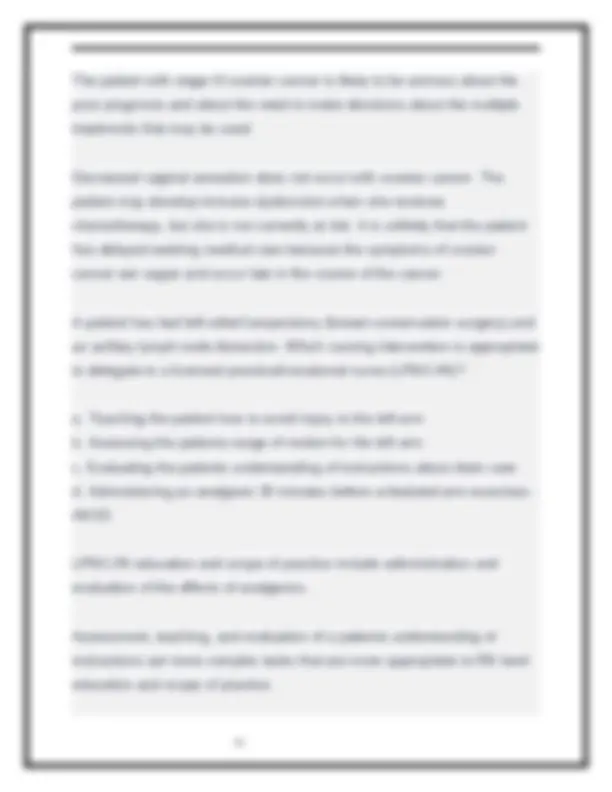
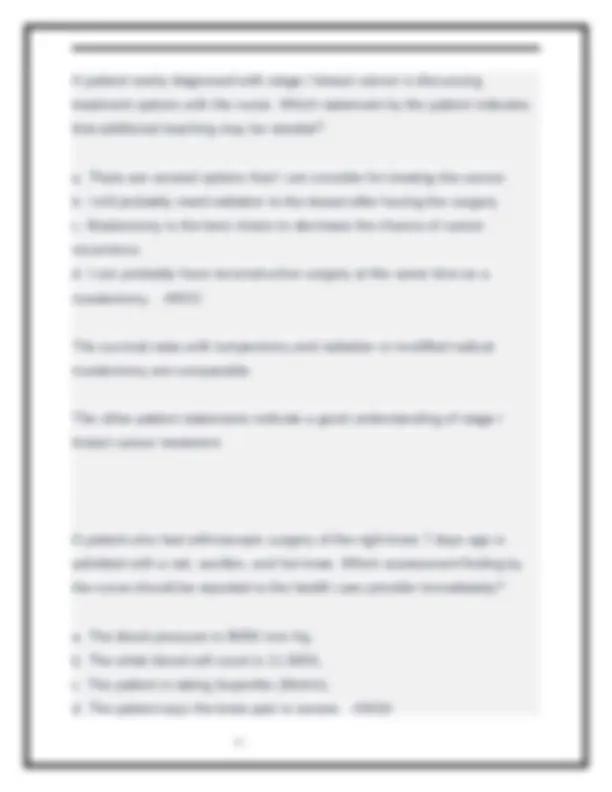
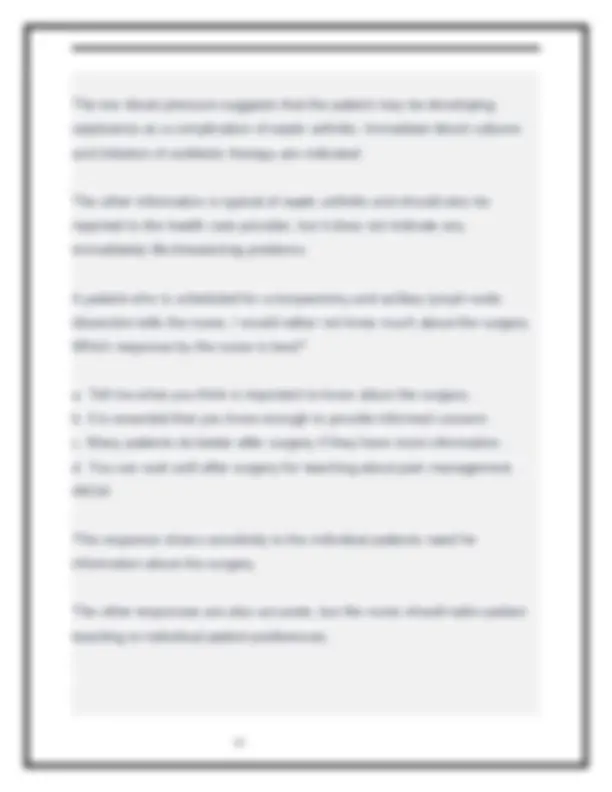
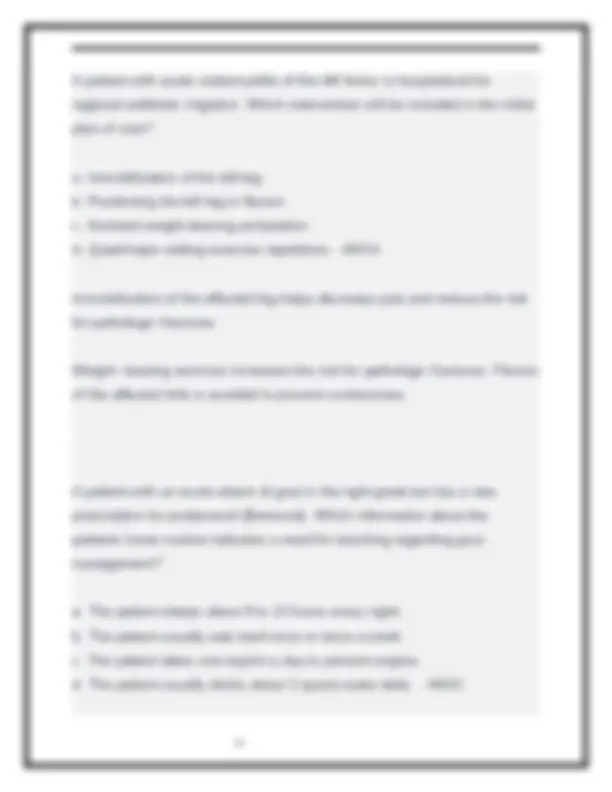
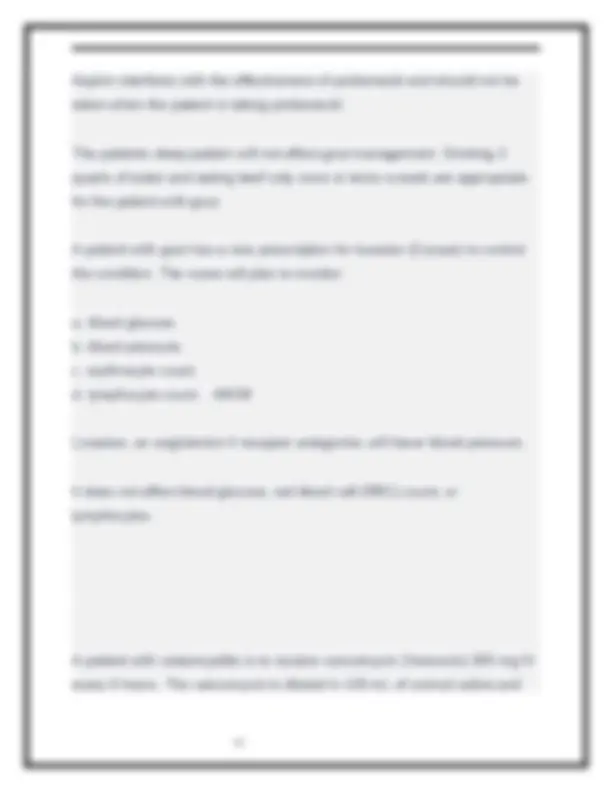
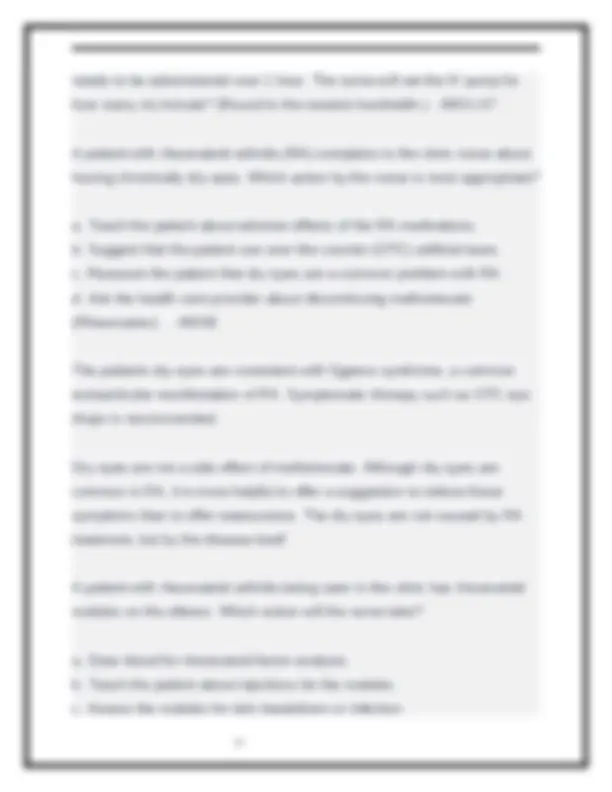
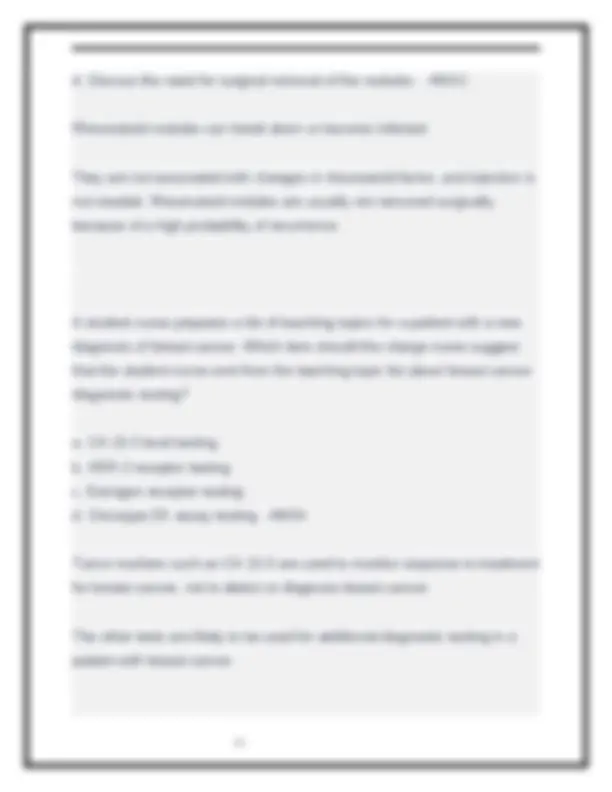
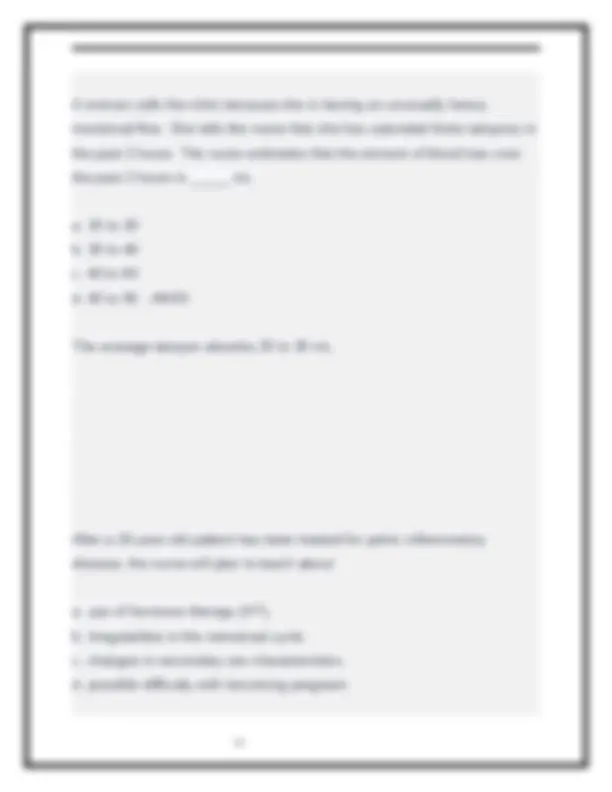

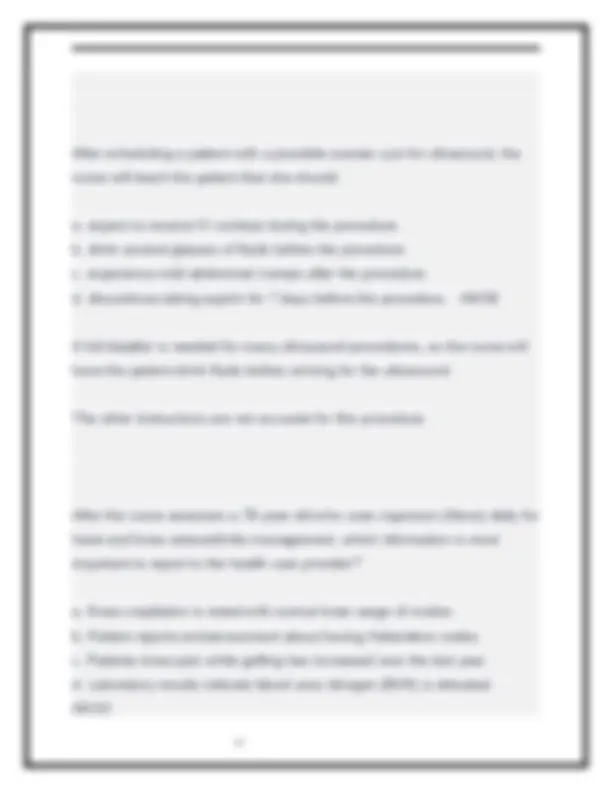
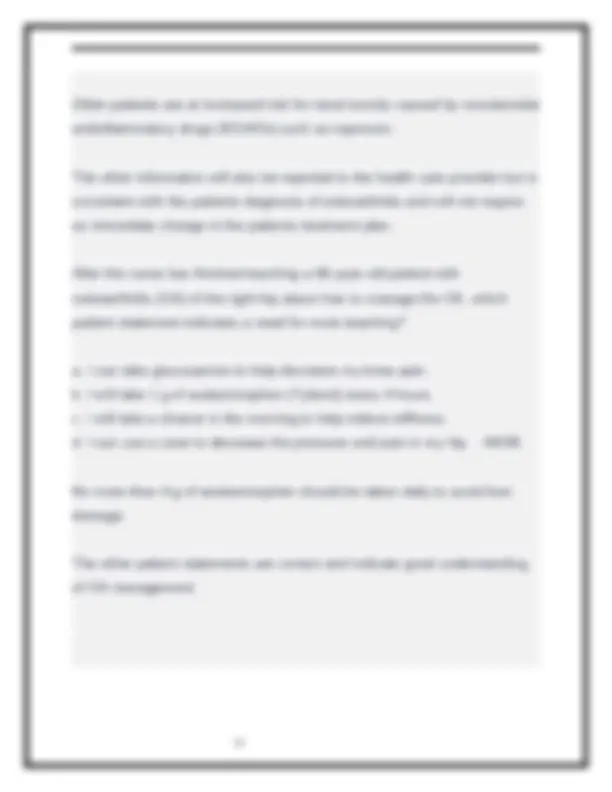
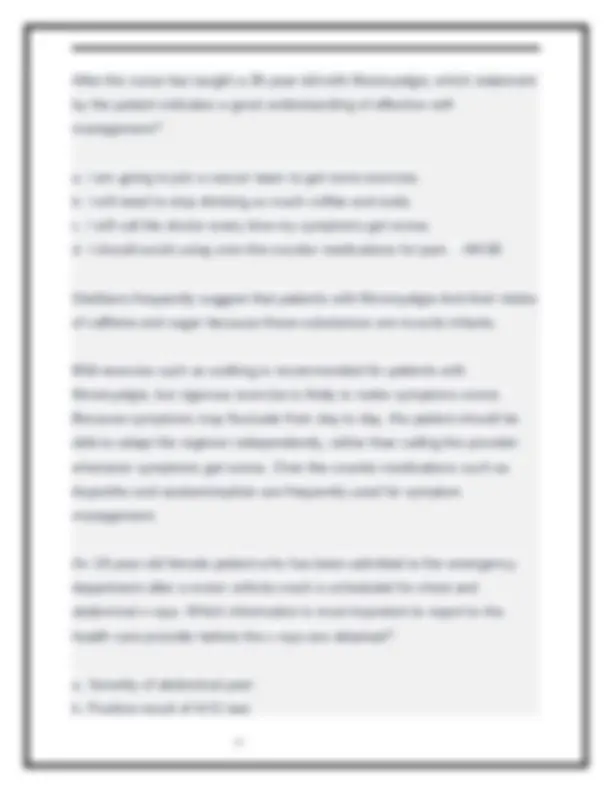
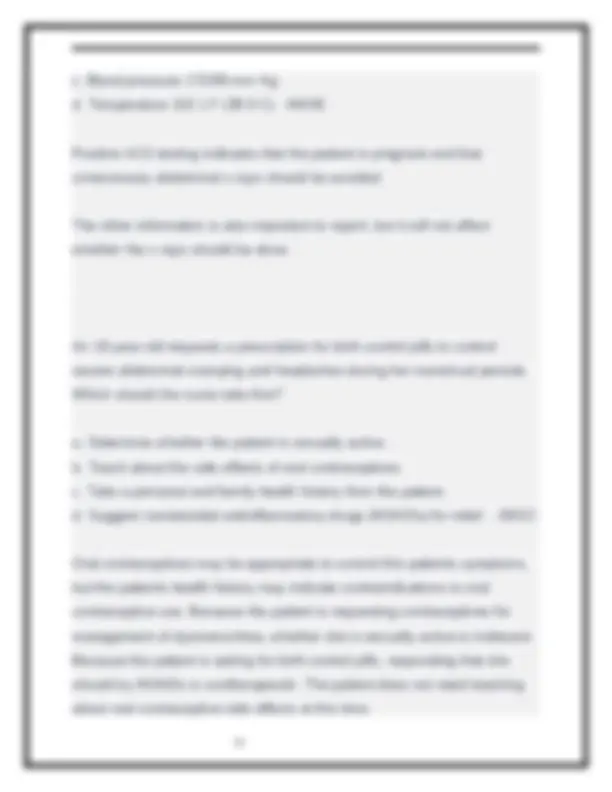
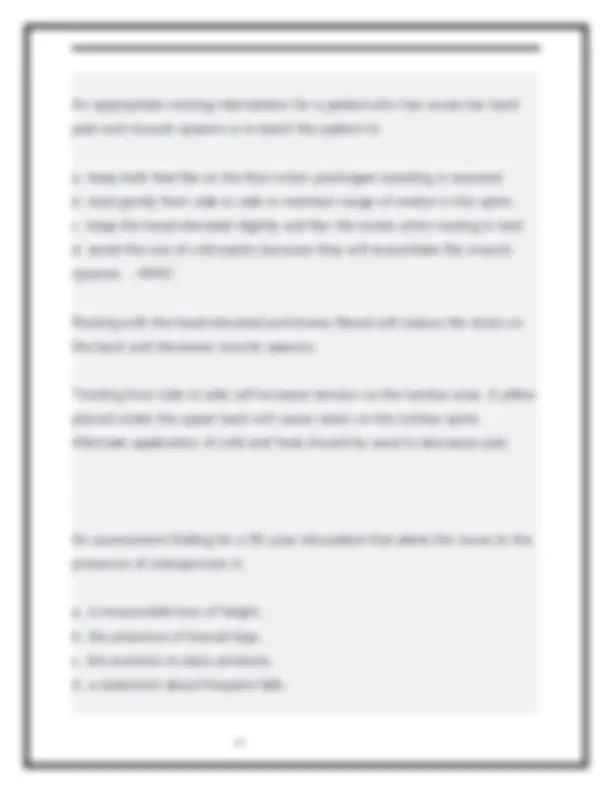
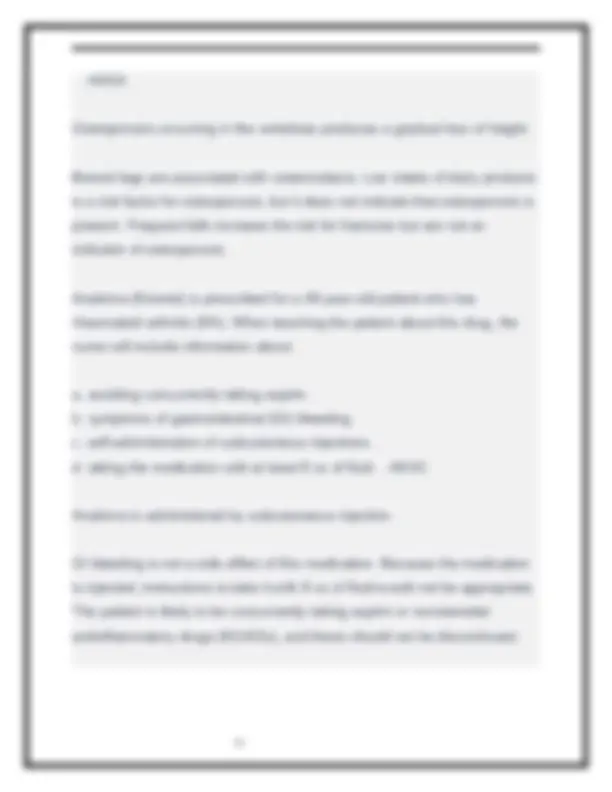
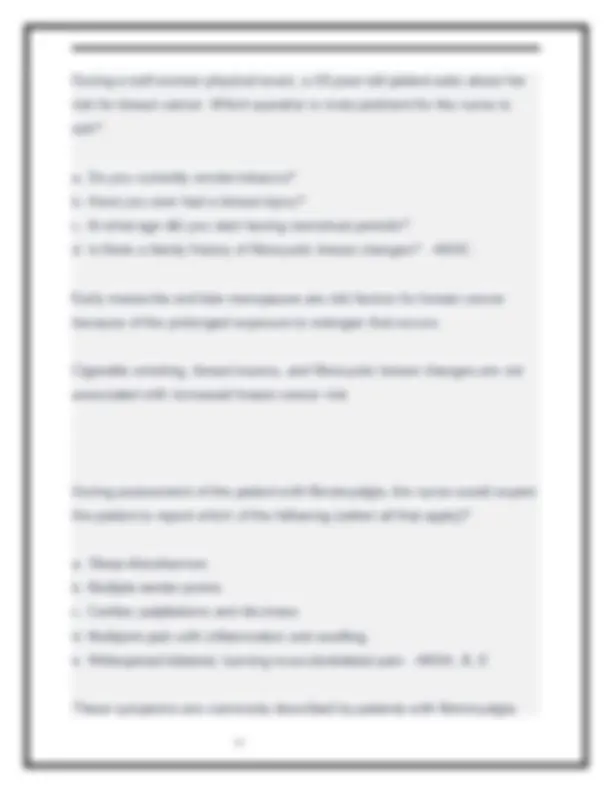
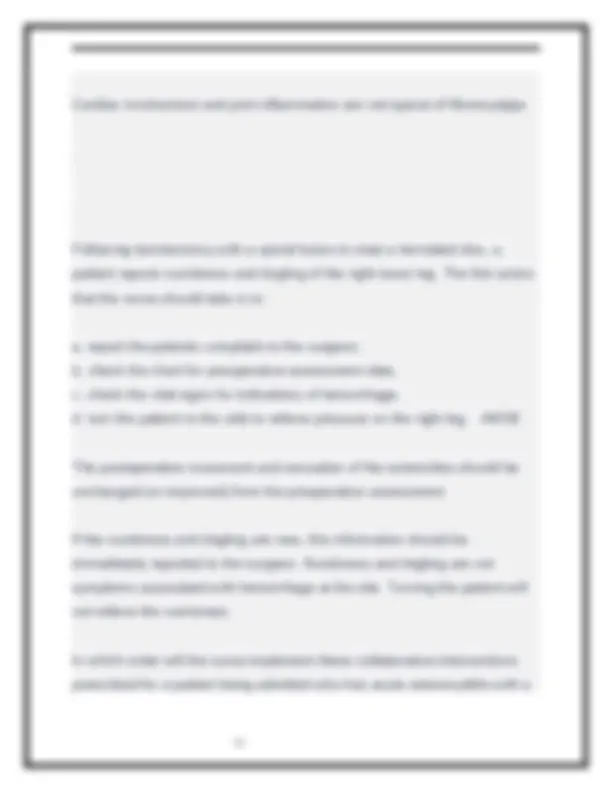
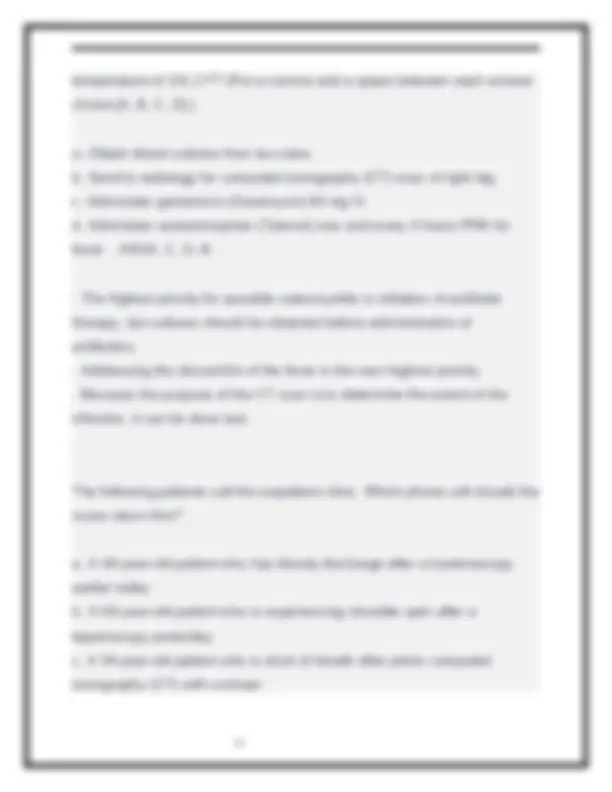
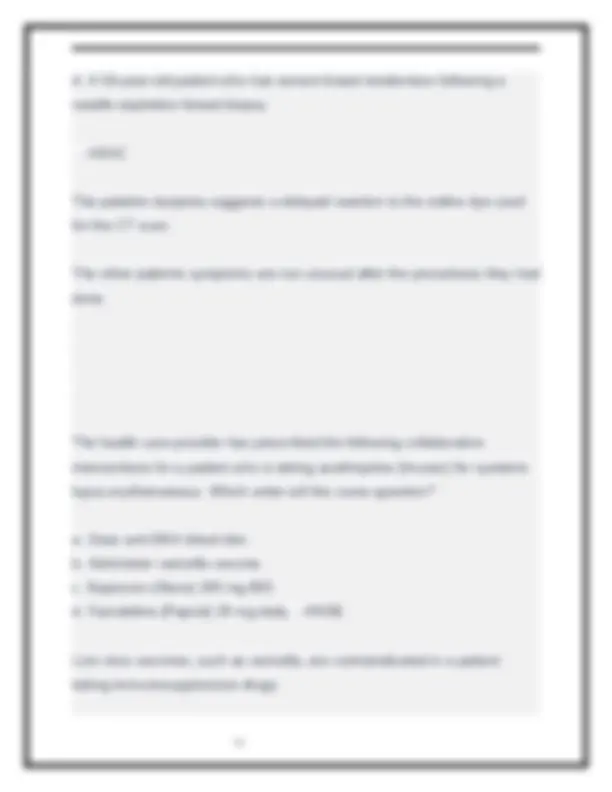
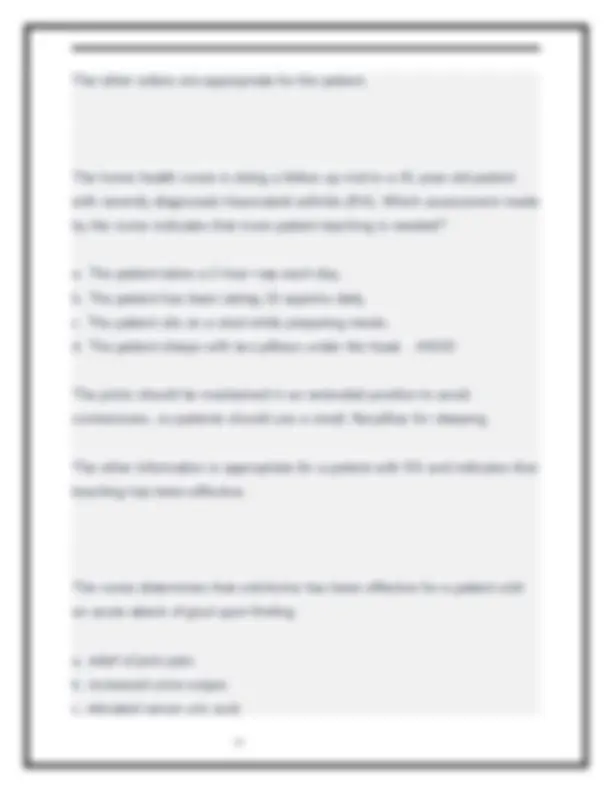
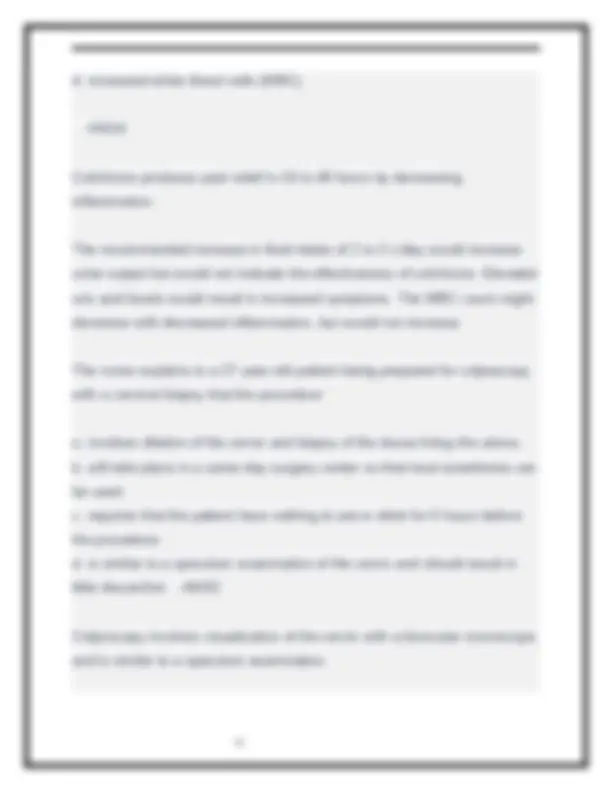
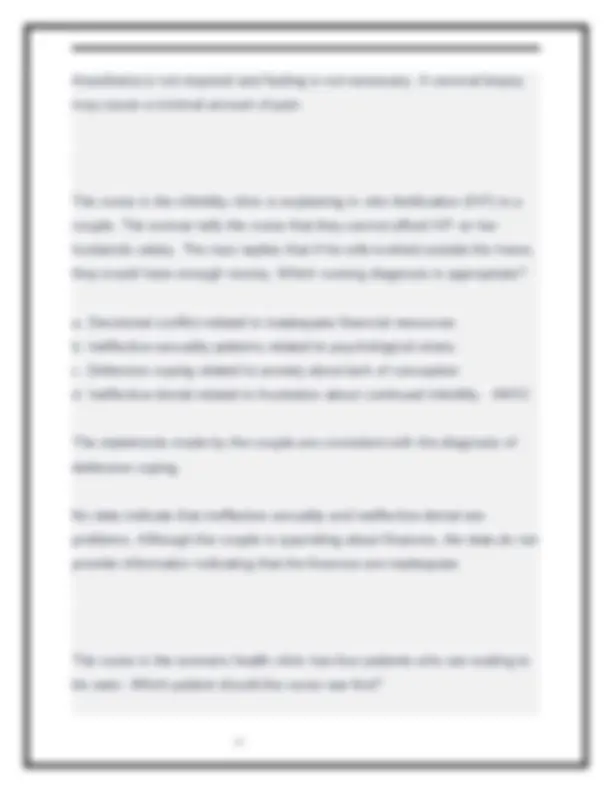

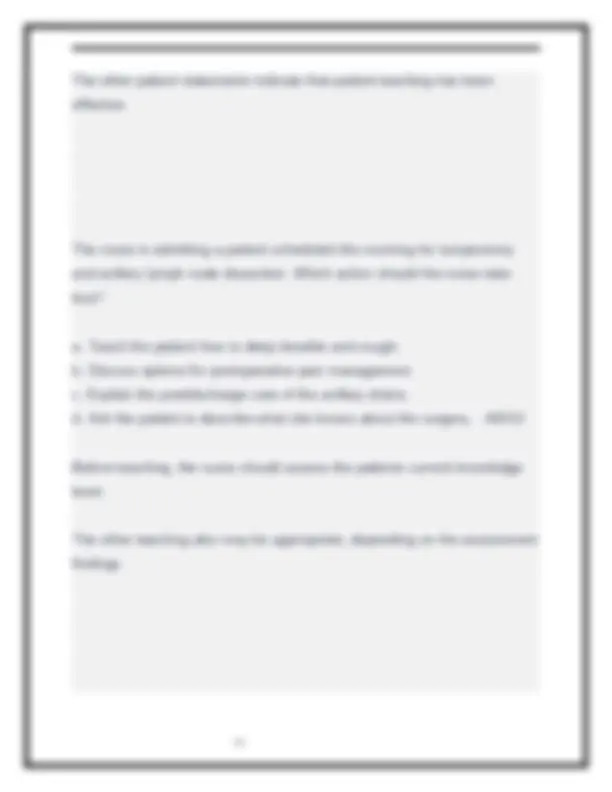
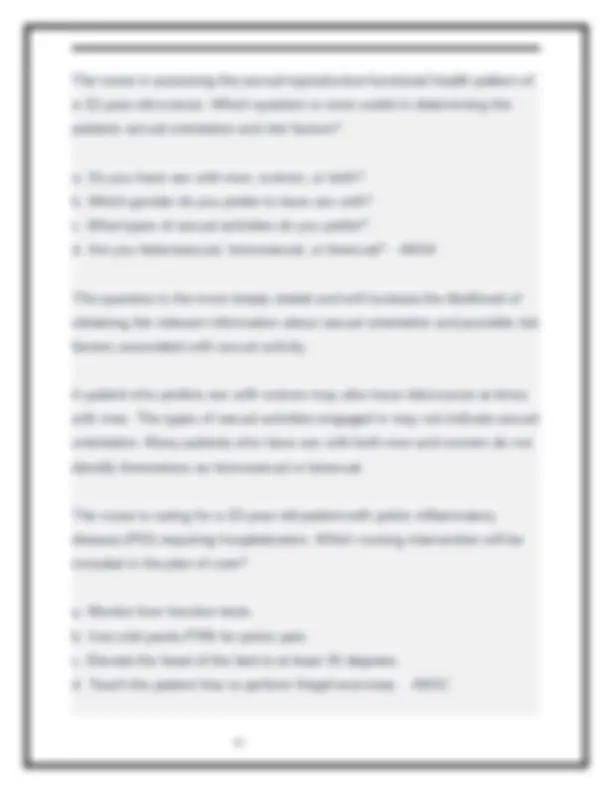
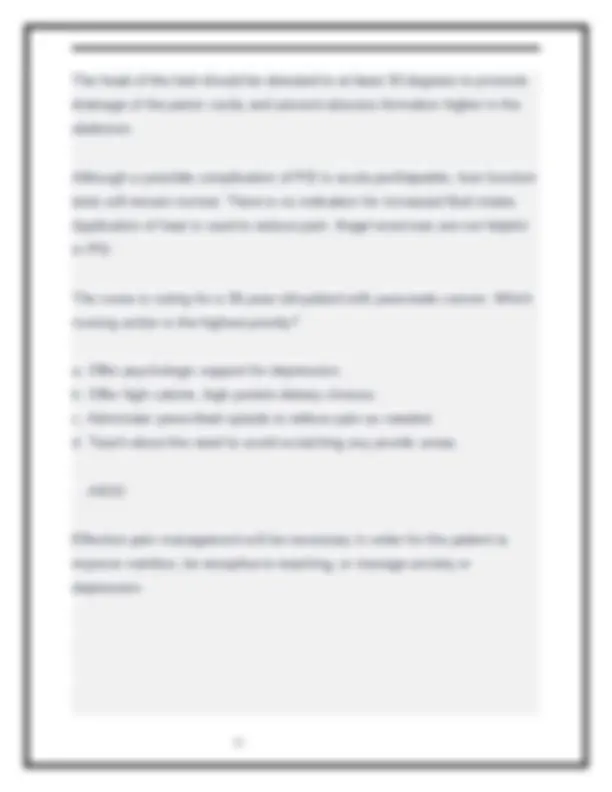
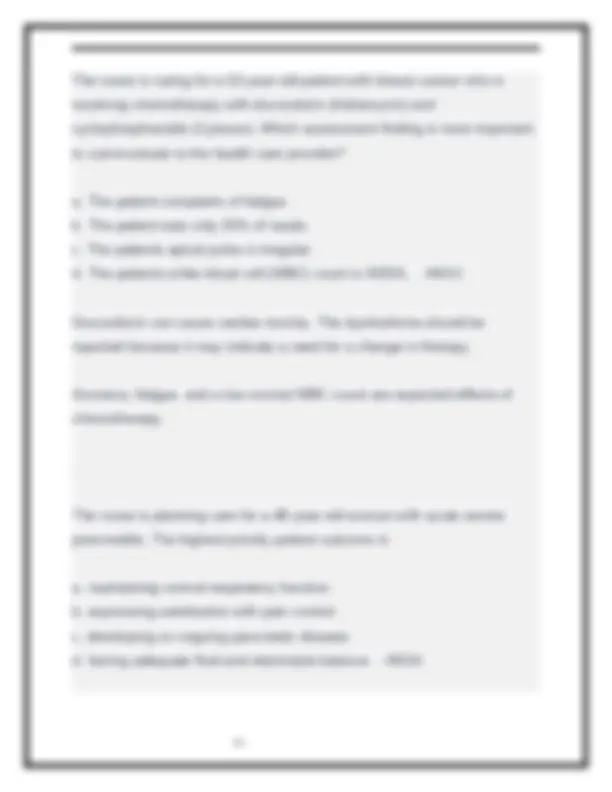
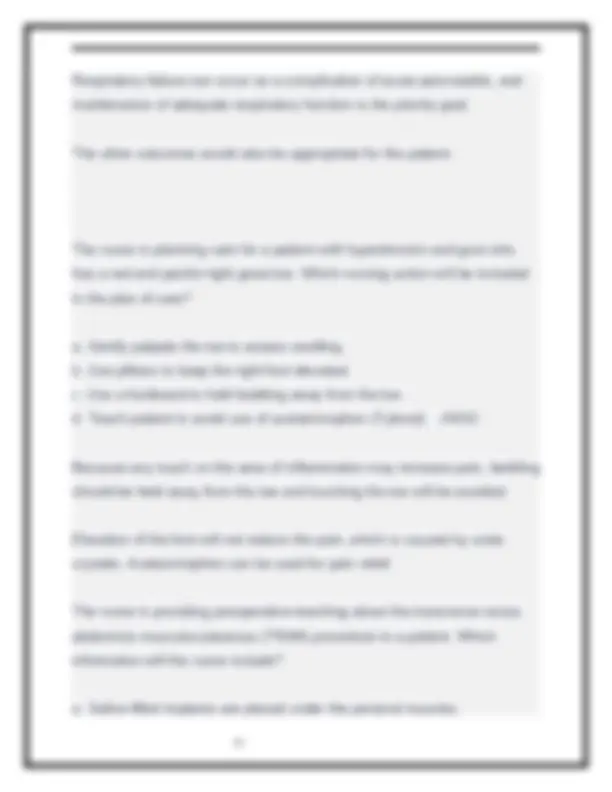
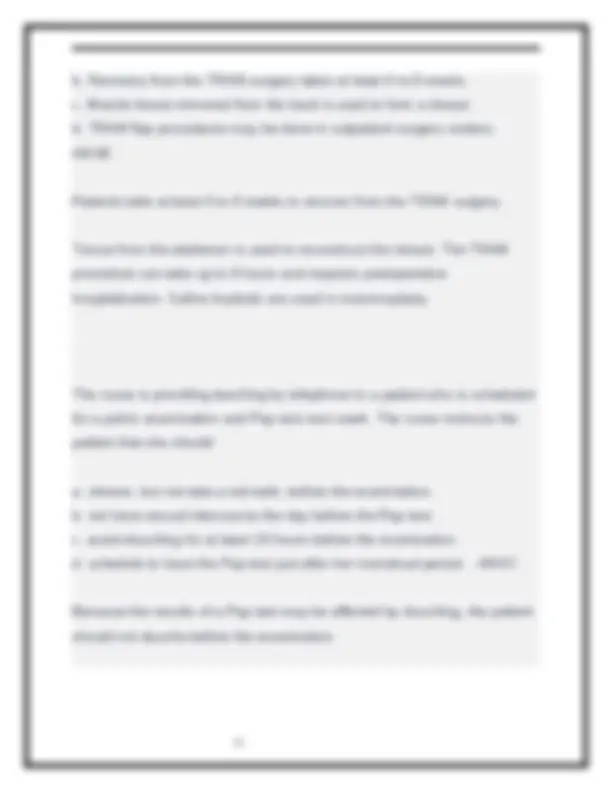
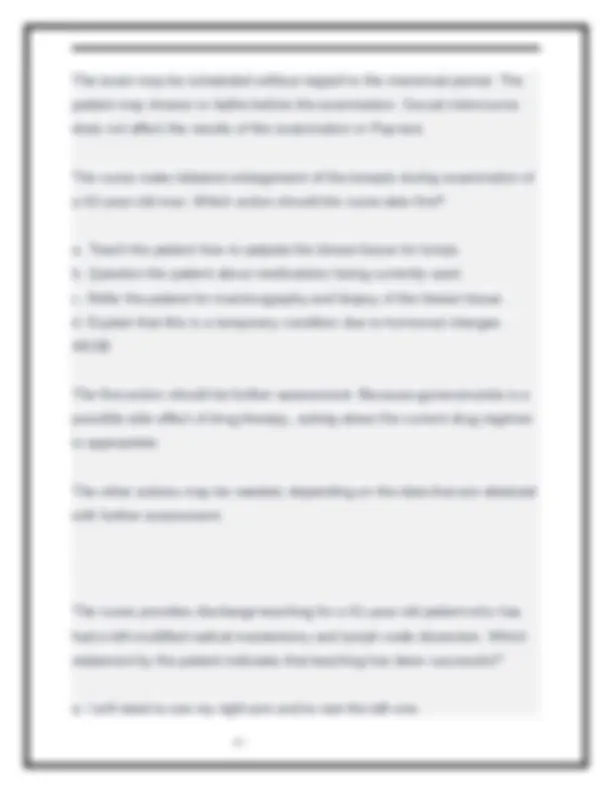
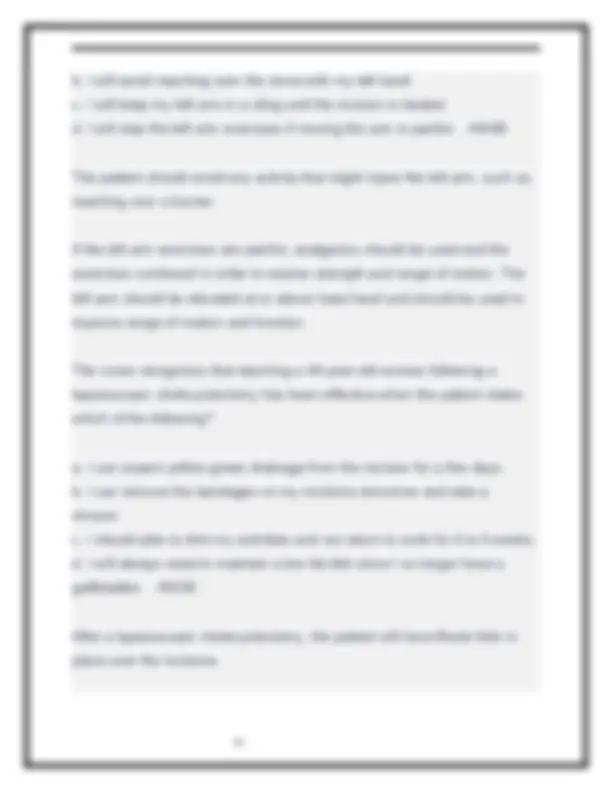
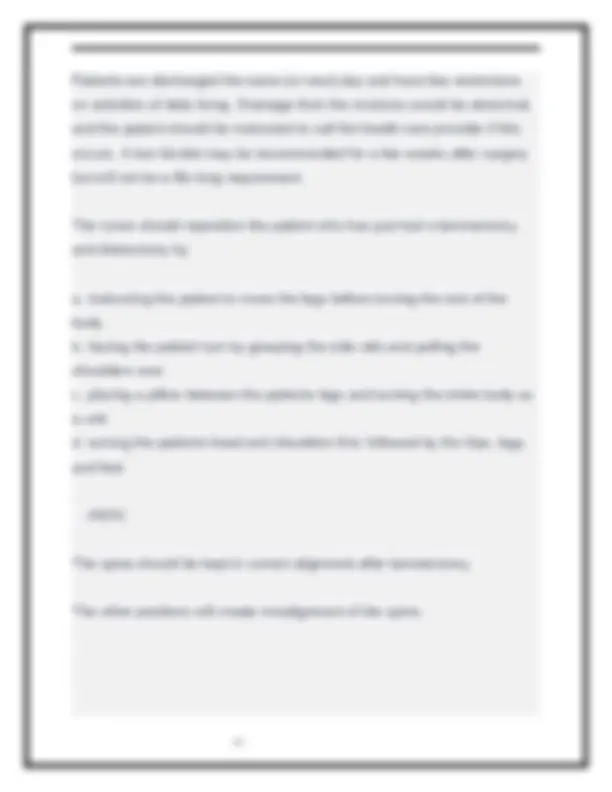
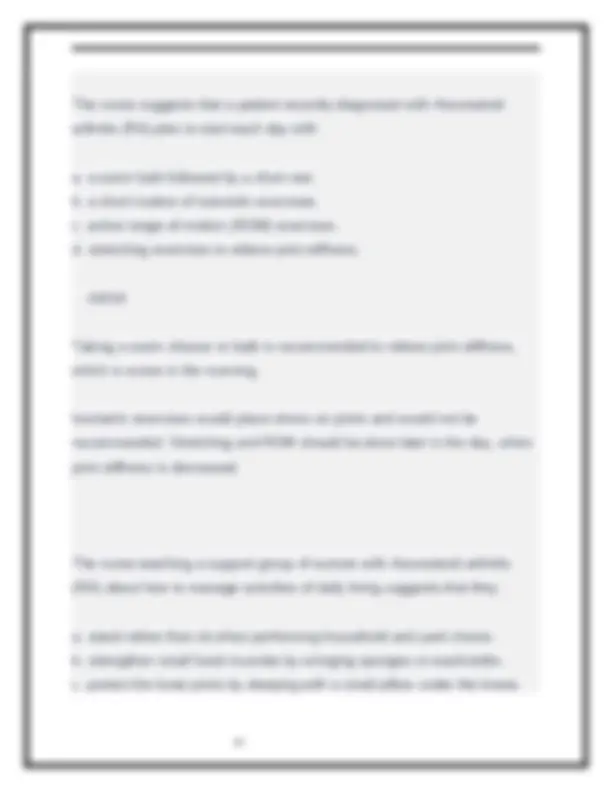

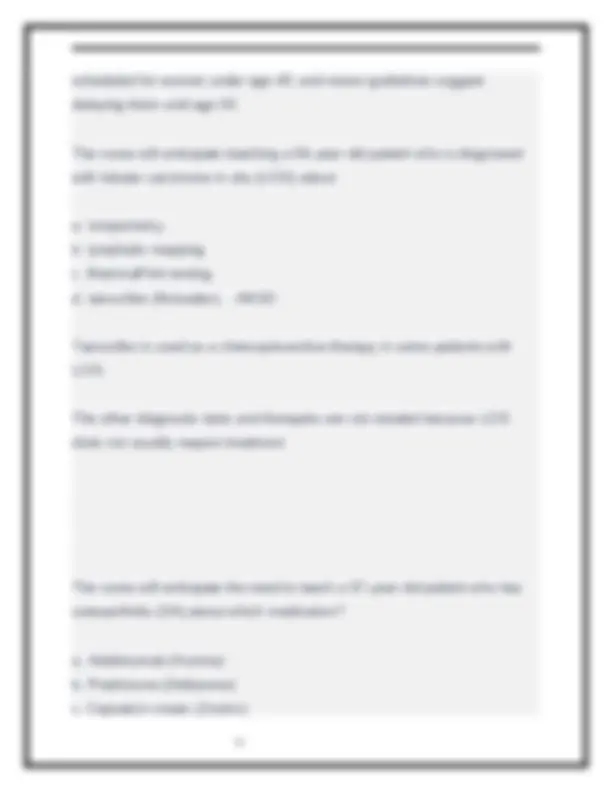
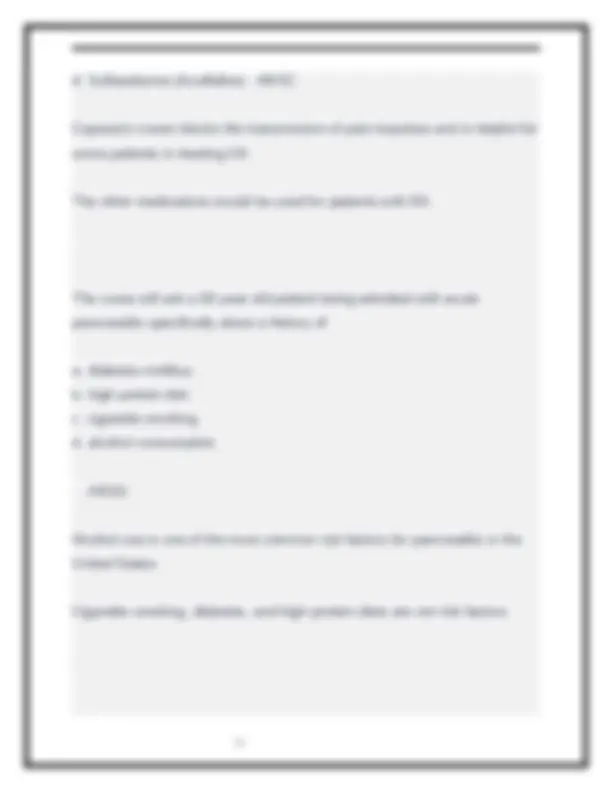
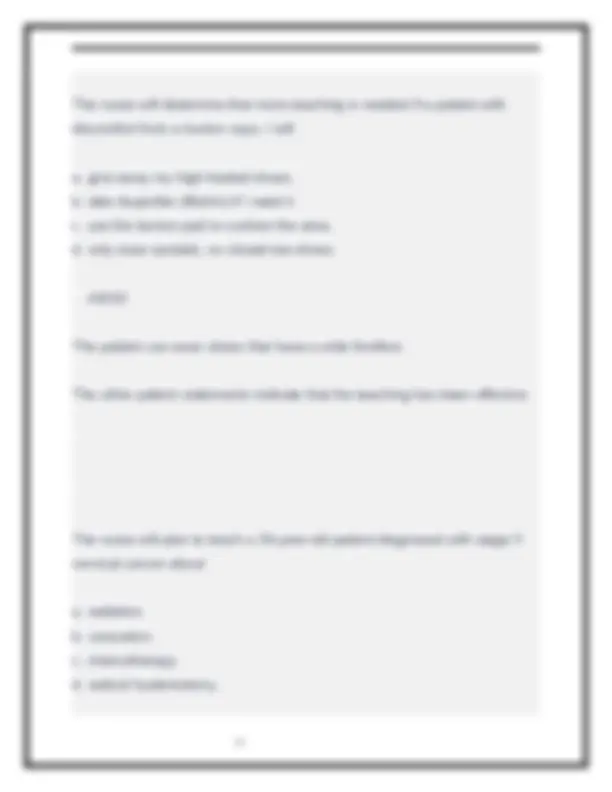
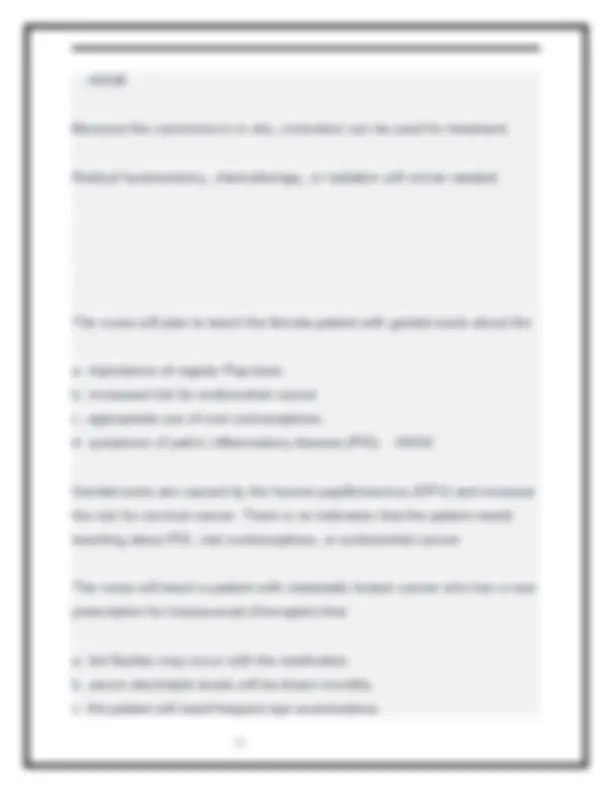
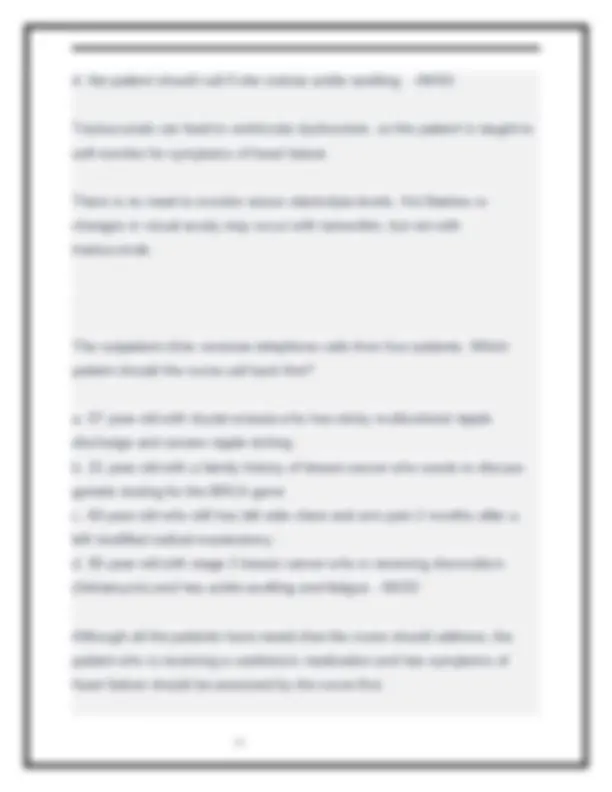
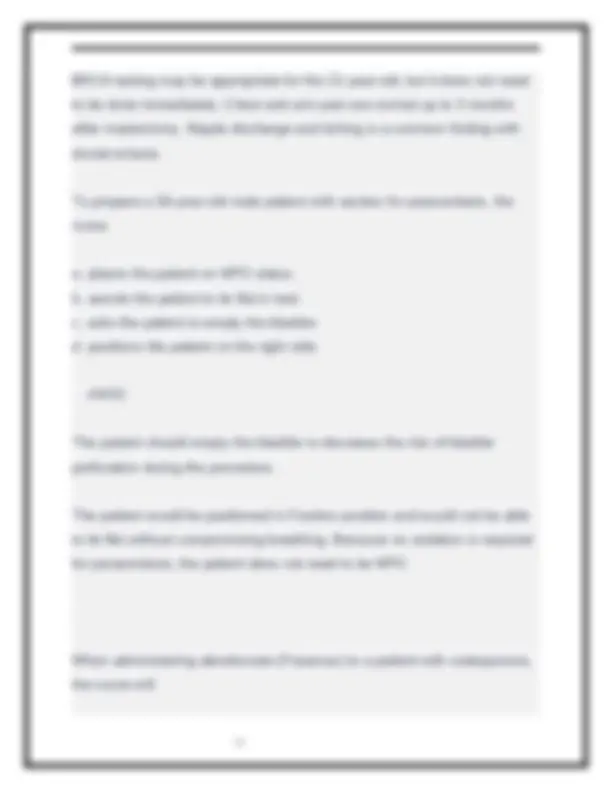
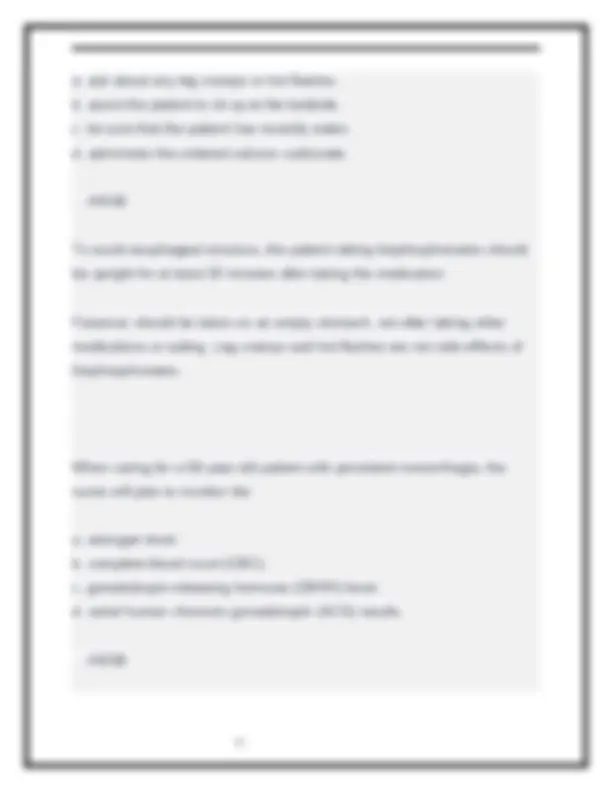
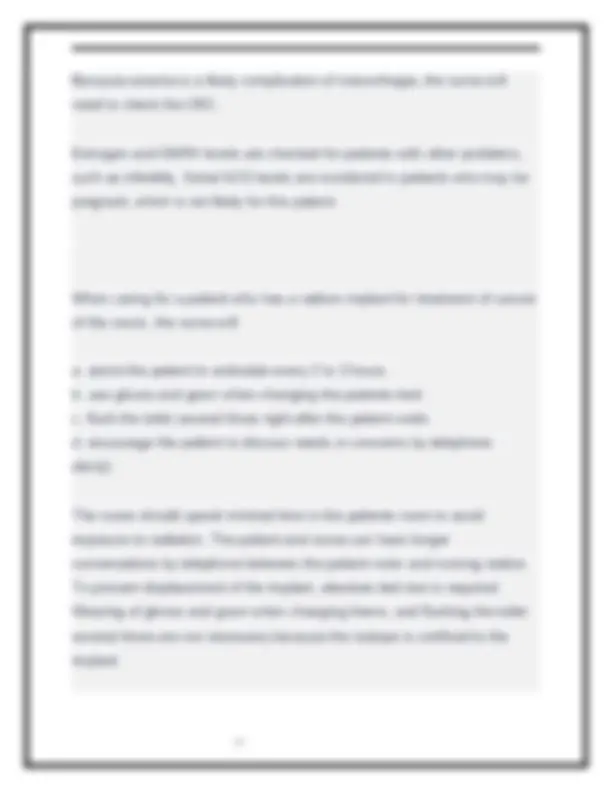
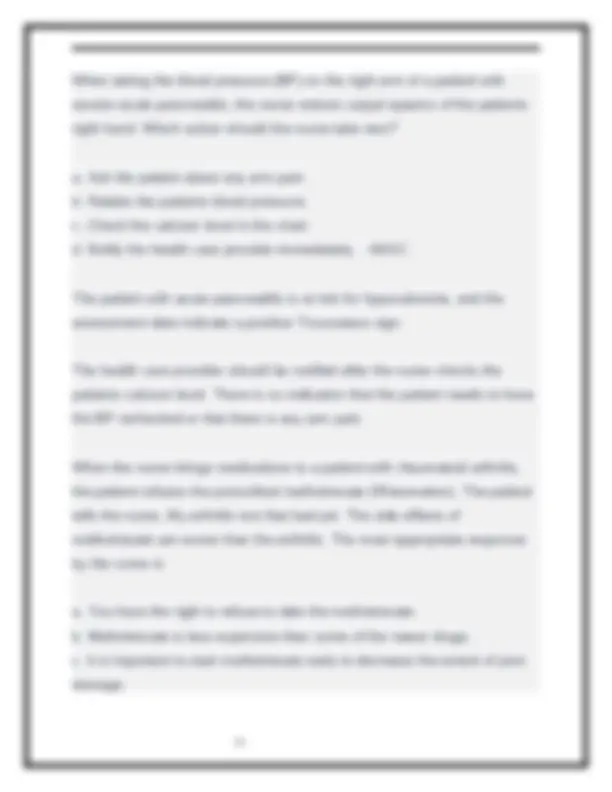
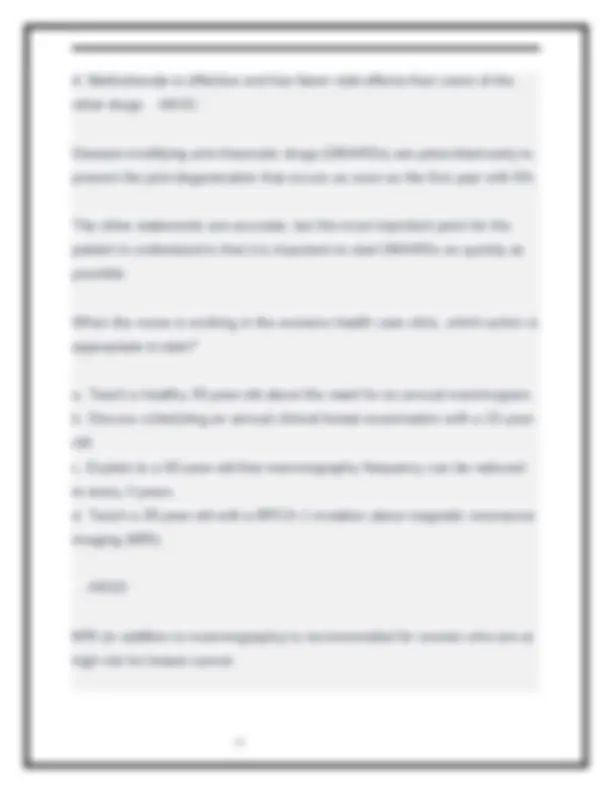
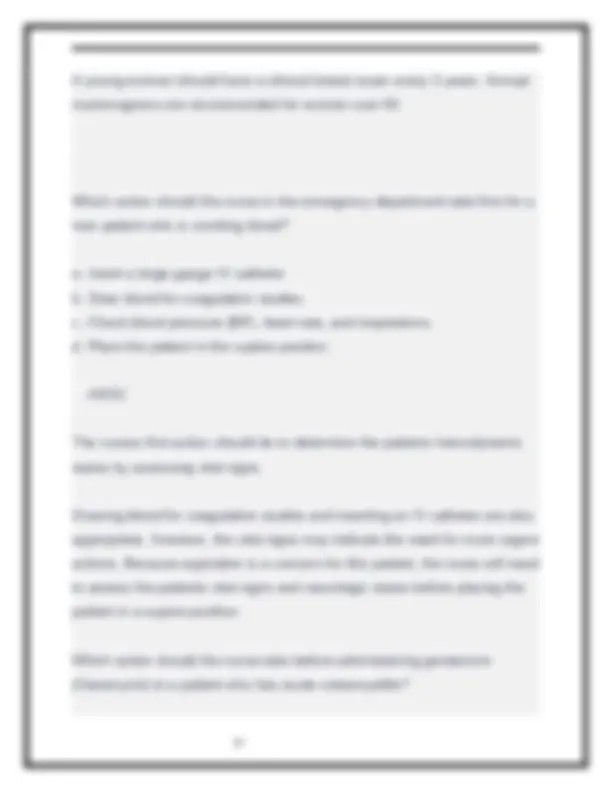
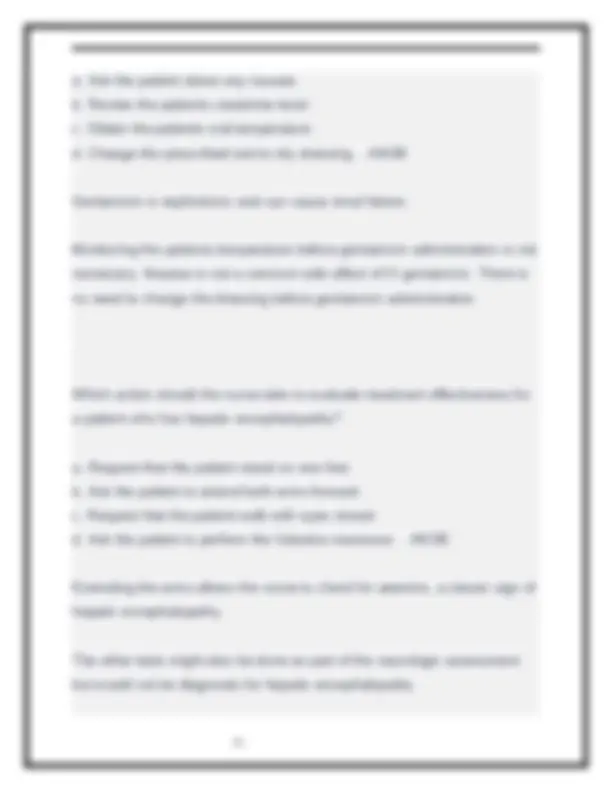
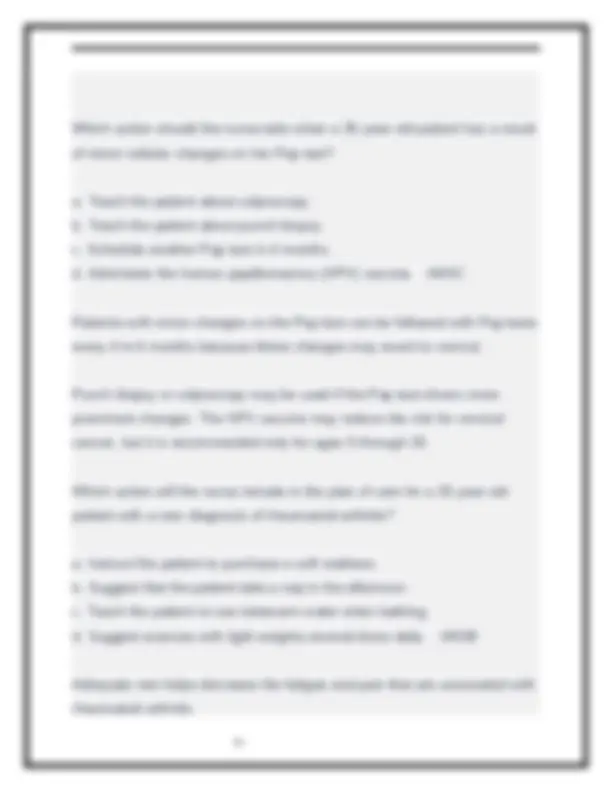
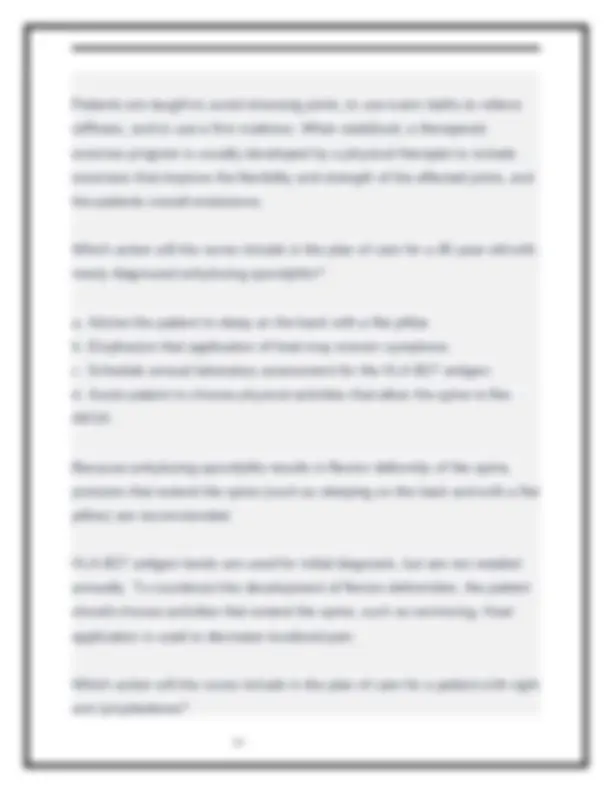
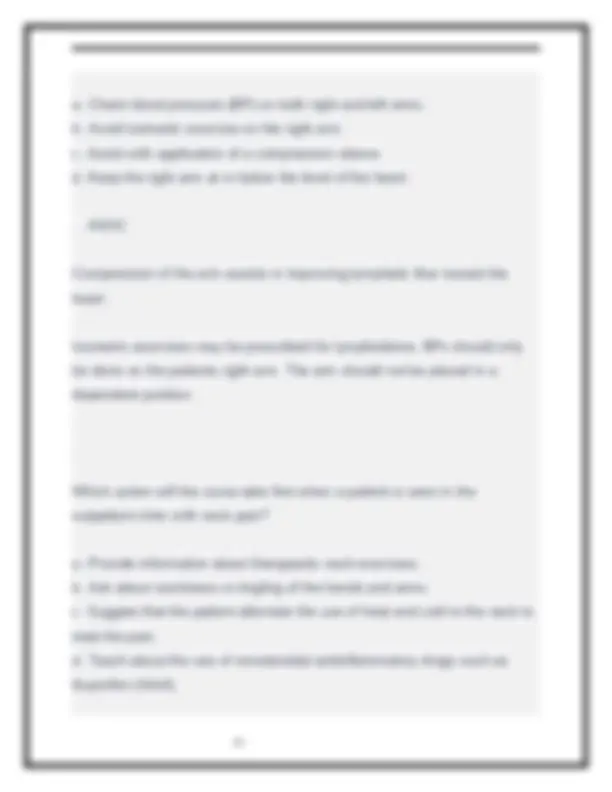
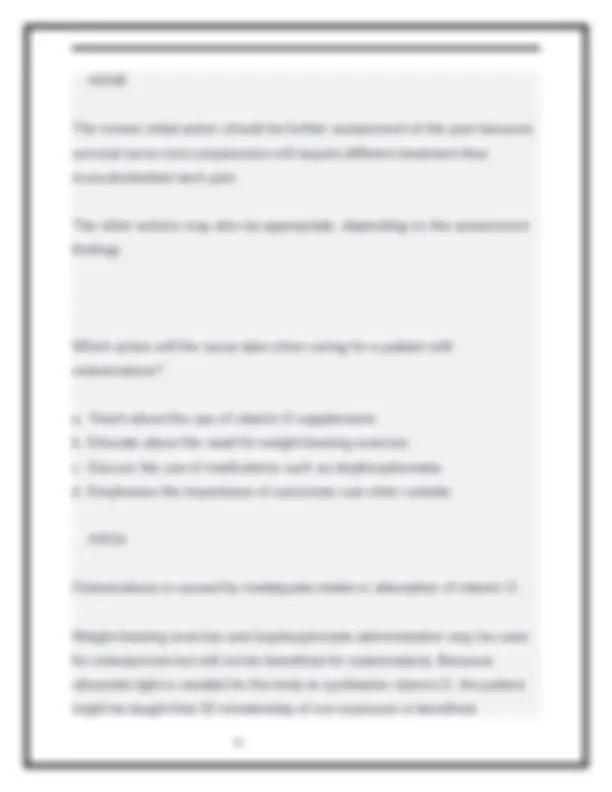
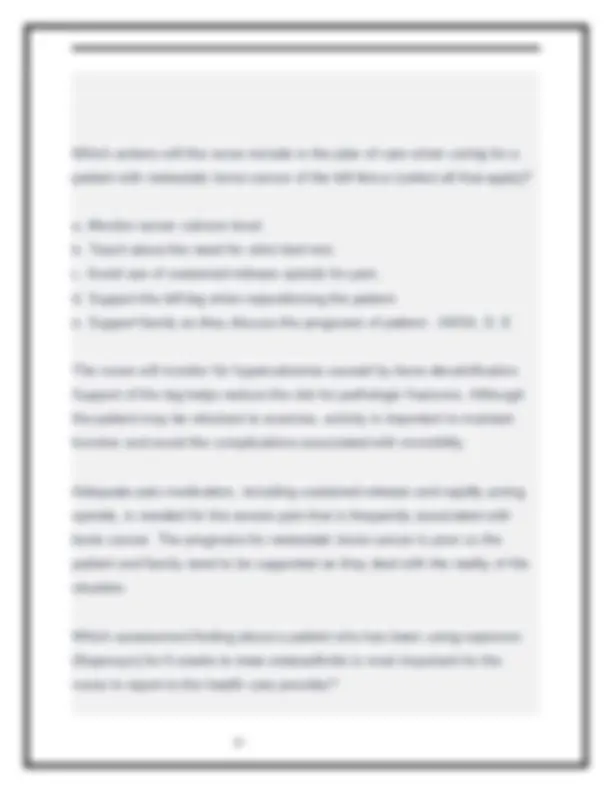
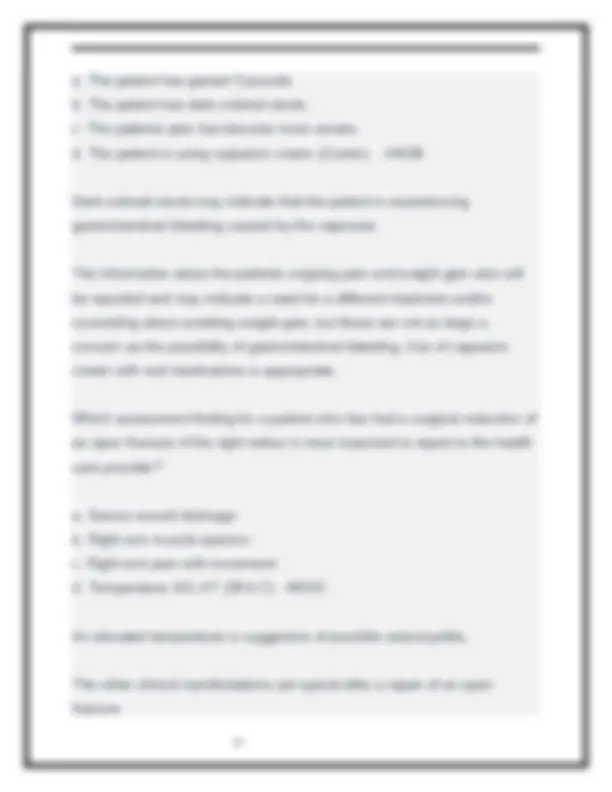
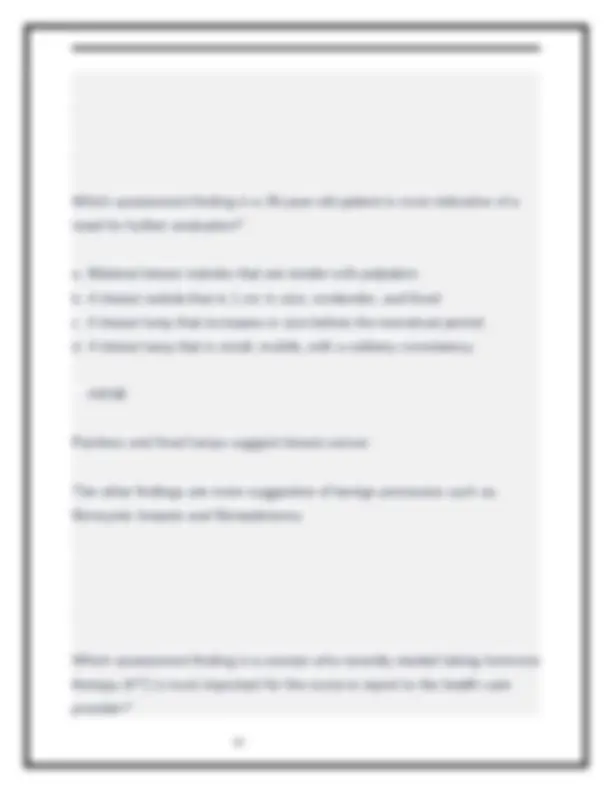
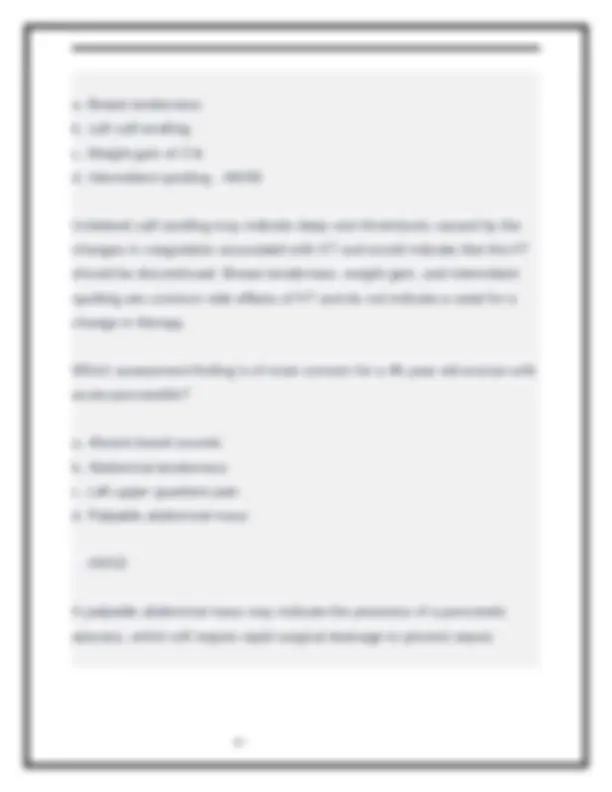
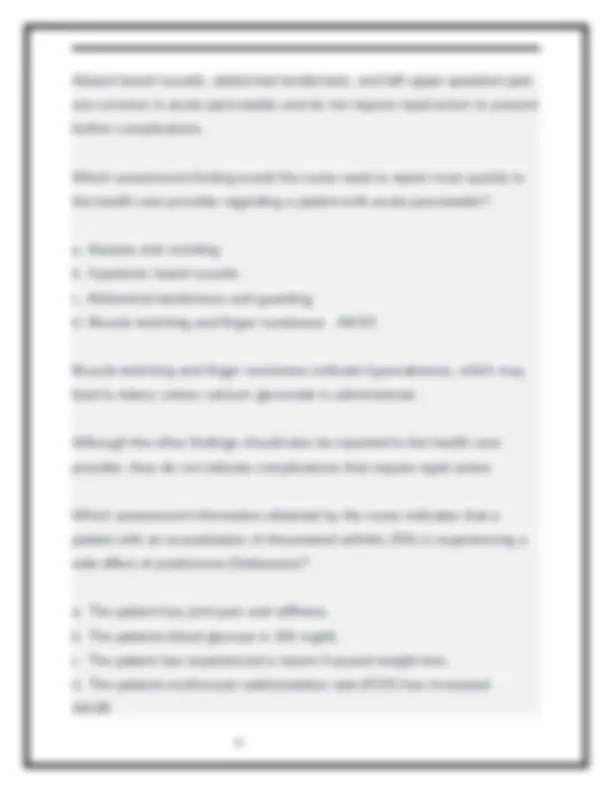
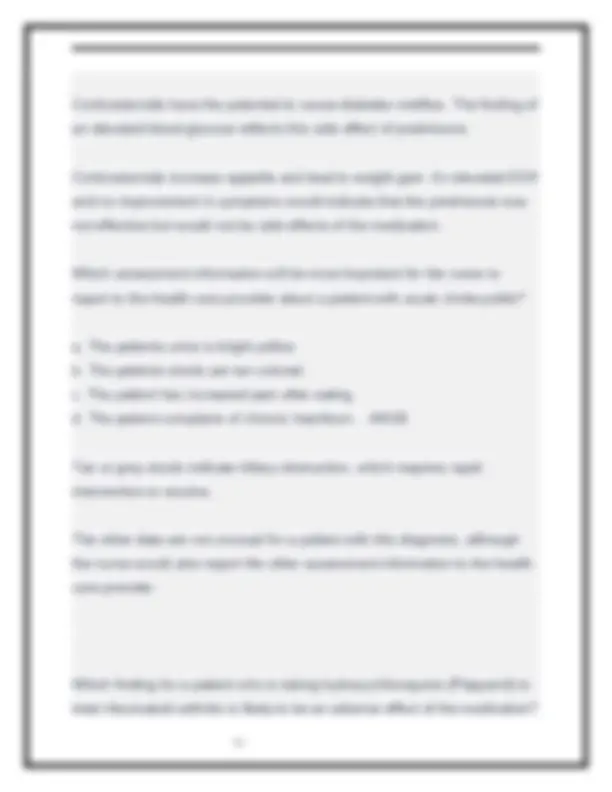
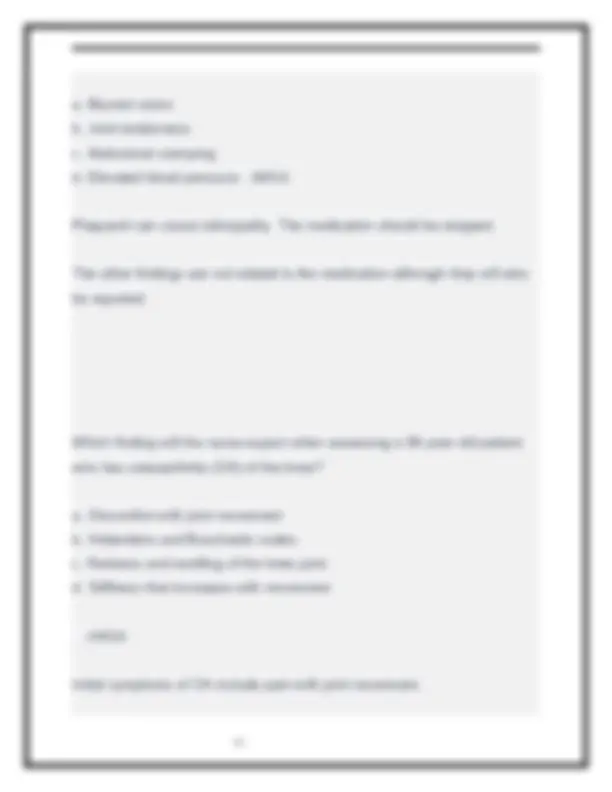
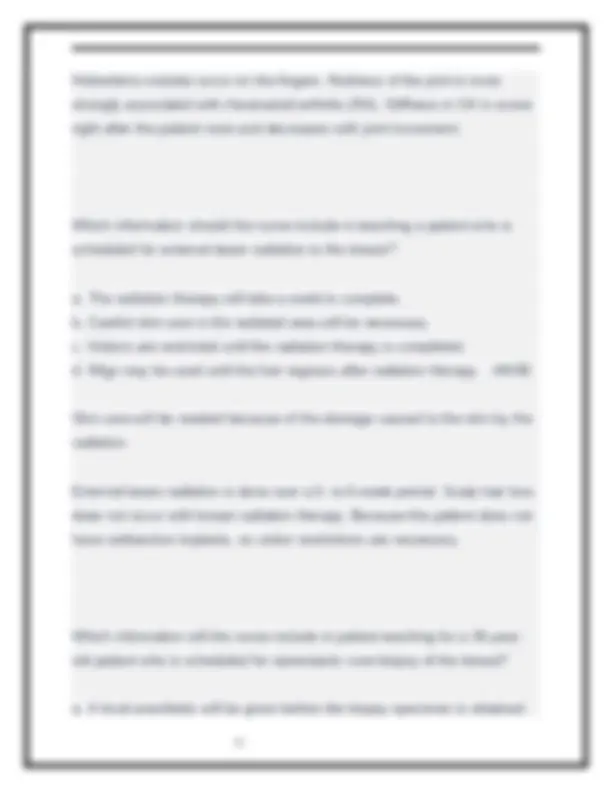
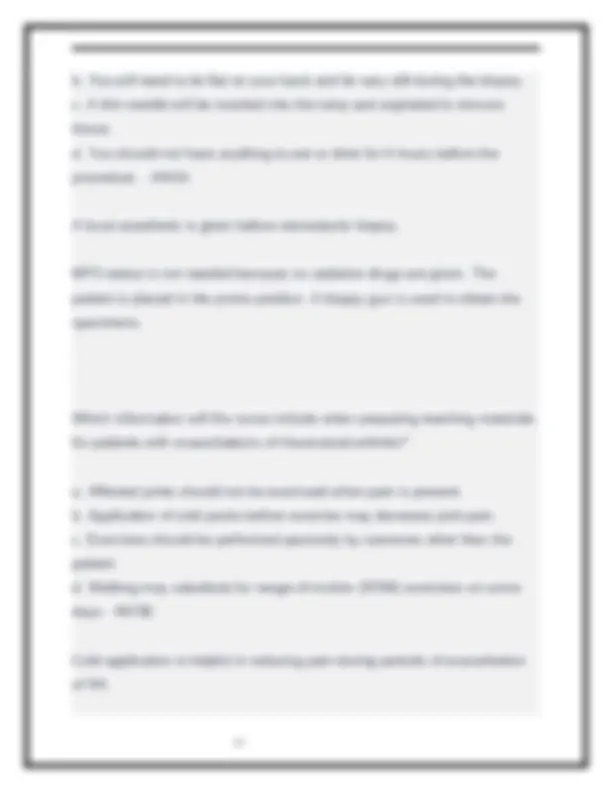
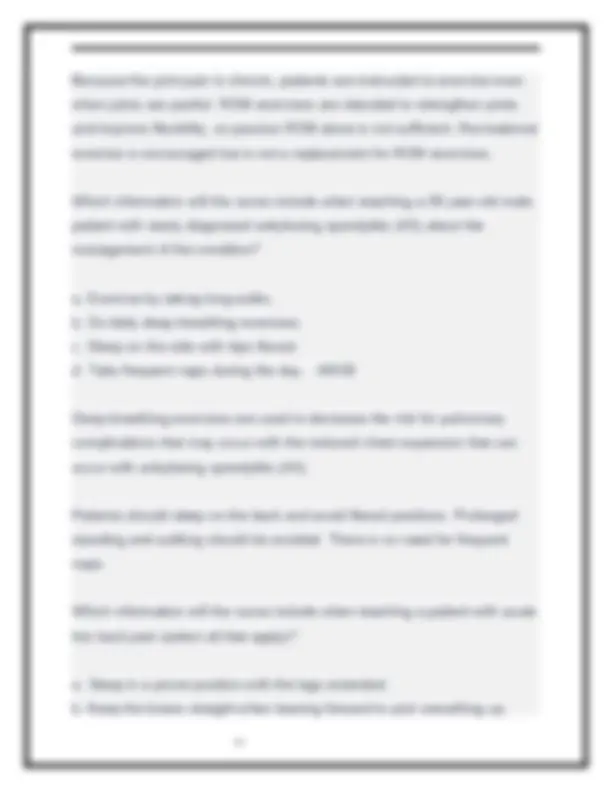
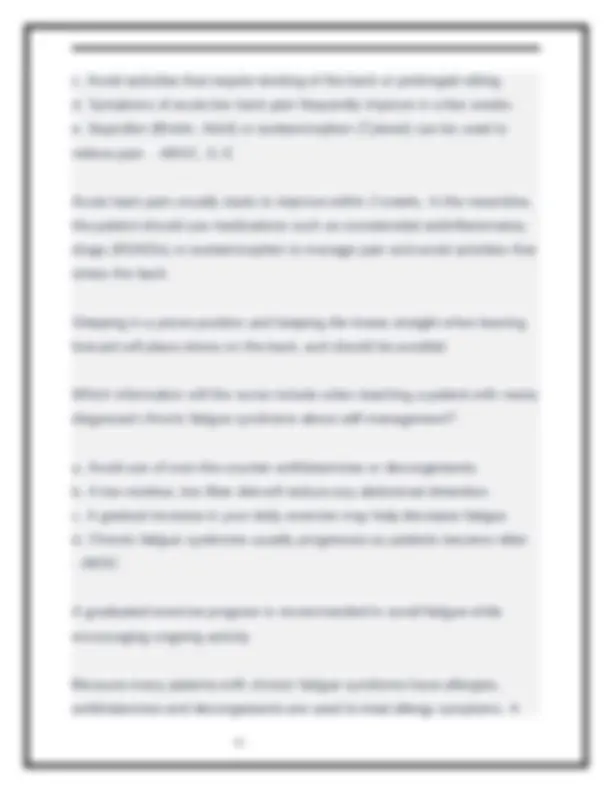
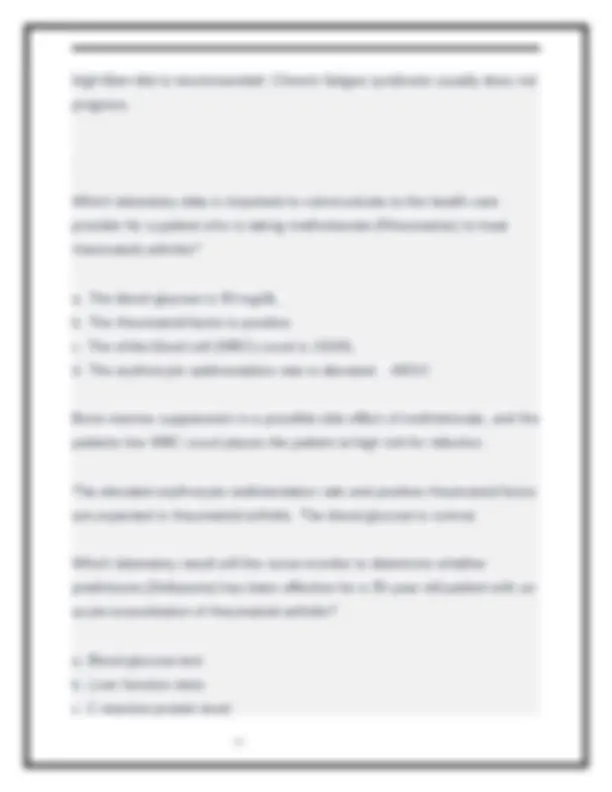
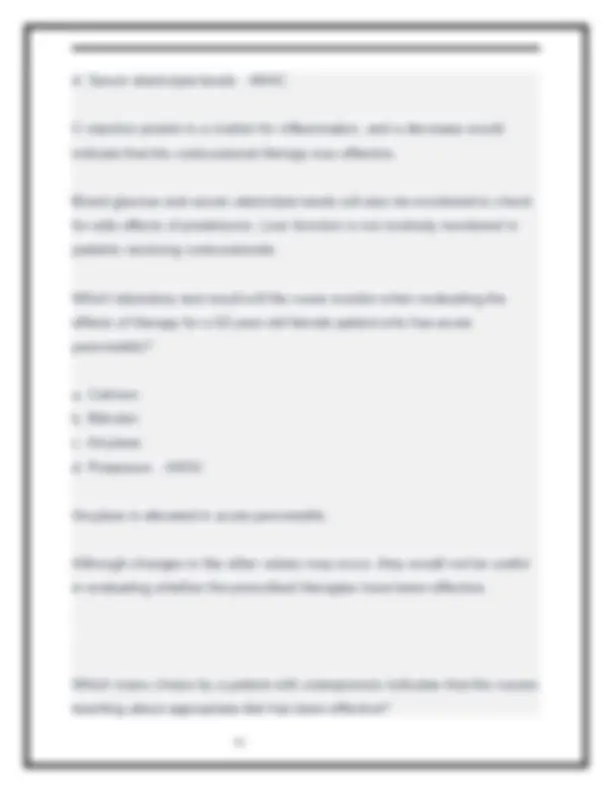
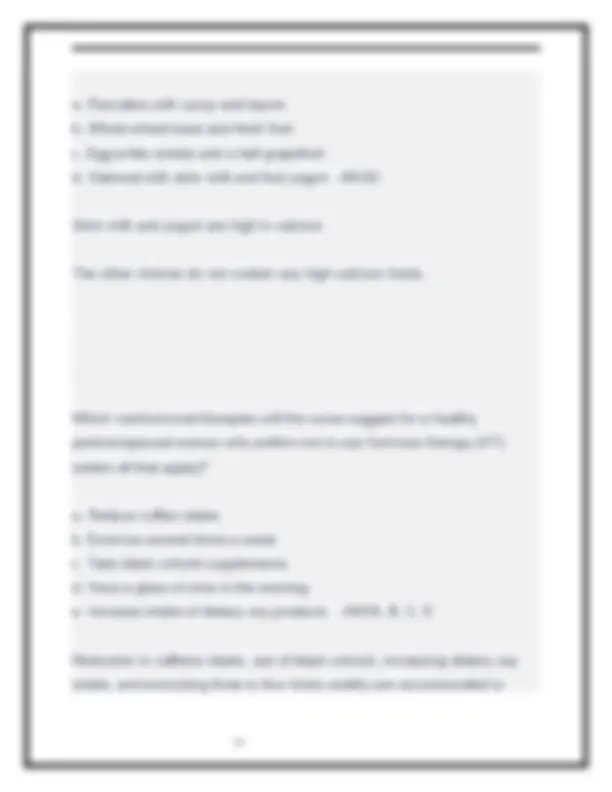
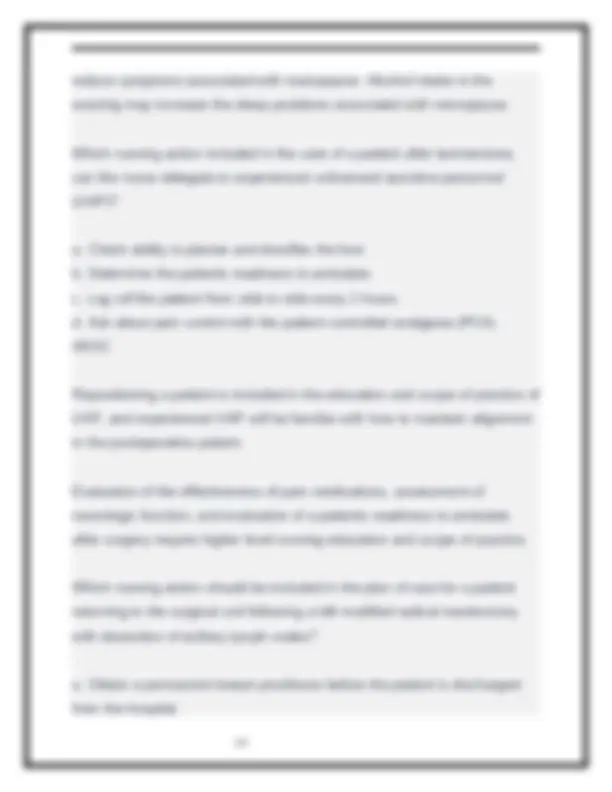


Study with the several resources on Docsity

Earn points by helping other students or get them with a premium plan


Prepare for your exams
Study with the several resources on Docsity

Earn points to download
Earn points by helping other students or get them with a premium plan
Community
Ask the community for help and clear up your study doubts
Discover the best universities in your country according to Docsity users
Free resources
Download our free guides on studying techniques, anxiety management strategies, and thesis advice from Docsity tutors
Level 2 - RNSG 1247 - Exam 2 Test Bank Latest Edition 2025-2026. Questions & Correct Answers. Graded A
Typology: Exams
1 / 106

This page cannot be seen from the preview
Don't miss anything!





























































































A 19-year-old patient calls the school clinic and tells the nurse, My menstrual period is very heavy this time. I have to change my tampon every 4 hours. Which action should the nurse take next? a. Tell the patient that her flow is not unusually heavy. b. Schedule the patient for an appointment later that day. c. Ask the patient how heavy her usual menstrual flow is. d. Have the patient call again if the heavy flow continues. - ANSC Because a heavy menstrual flow is usually indicated by saturating a pad or tampon in 1 to 2 hours, the nurse should first assess how heavy the patients usual flow is. There is no need to schedule the patient for an appointment that day. The patient may need to call again, but this is not the first action that the nurse should take. Telling the patient that she does not have a heavy flow implies that the patients concern is not important. A 19-year-old patient hospitalized with a fever and red, hot, and painful knees is suspected of having septic arthritis. Information obtained during
the nursing history that indicates a risk factor for septic arthritis is that the patient a. had several knee injuries as a teenager. b. recently returned from South America. c. is sexually active with multiple partners. d. has a parent who has rheumatoid arthritis. - ANSC Neisseria gonorrhoeae is the most common cause for septic arthritis in sexually active young adults. The other information does not point to any risk for septic arthritis. . A 19-year-old visits the health clinic for a routine checkup. Which question should the nurse ask to determine whether a Pap test is needed? a. Have you had sexual intercourse? b. Do you use any illegal substances? c. Do you have cramping with your periods? d. At what age did your menstrual periods start? - ANSA The current American Cancer Society recommendation is that a Pap test be done every 3 years, starting 3 years after the first sexual intercourse and no later than age 21.
b. Ask about any recent stressful lifestyle changes. c. Measure the patients current height and weight. d. Question the patient about prescribed medications. - ANSA Pregnancy should always be considered a possible cause of amenorrhea in women of childbearing age. The other actions are also appropriate, but it is important to check for pregnancy in this patient because pregnancy will require rapid implementation of actions to promote normal fetal development such as changes in lifestyle, folic acid intake, etc. A 23-year-old patient with a history of muscular dystrophy is hospitalized with pneumonia. Which nursing action will be included in the plan of care? a. Logroll the patient every 2 hours. b. Assist the patient with ambulation. c. Discuss the need for genetic testing with the patient. d. Teach the patient about the muscle biopsy procedure. - ANSB Because the goal for the patient with muscular dystrophy is to keep the patient active for as long as possible, assisting the patient to ambulate will be part of the care plan. The patient will not require logrolling. Muscle biopsies are necessary to confirm the diagnosis but are not necessary for a patient who already has a diagnosis. There is no need for genetic testing because the patient already knows the diagnosis.
A 24-year-old female says she wants to begin using oral contraceptives. Which information from the nursing assessment is most important to report to the health care provider? a. The patient quit smoking 5 months previously. b. The patients blood pressure is 154/86 mm Hg. c. The patient has not been vaccinated for rubella. d. The patient has chronic iron-deficiency anemia. - ANSB Because hypertension increases the risk for morbidity and mortality in women taking oral contraceptives, the patients blood pressure should be controlled before oral contraceptives are prescribed. The other information also will be reported but will not affect the choice of contraceptive. . A 24-year-old patient with pelvic inflammatory disease (PID) is being treated with oral antibiotics as an outpatient. Which instruction will be included in patient teaching? a. Abdominal pain may persist for several weeks. b. Return for a follow-up appointment in 2 to 3 days. c. Instruct a male partner to use a condom during sexual intercourse for the next week.
Activity intolerance is a possible problem for patients with SLE, but the information about this patient does not support this as a diagnosis. The rash with SLE is nonpruritic. There is no evidence of lack of social skills for this patient. A 25-year-old woman has an induced abortion with suction curettage at an ambulatory surgical center. Which instructions will the nurse include when discharging the patient? a. Heavy vaginal bleeding is expected for about 2 weeks. b. You should abstain from sexual intercourse for 2 weeks. c. Contraceptives should be avoided until your reexamination. d. Irregular menstrual periods are expected for the next few months. - ANSB Because infection is a possible complication of this procedure, the patient is advised to avoid intercourse until the reexamination in 2 weeks. Patients may be started on contraceptives on the day of the procedure. The patient should call the doctor if heavy vaginal bleeding occurs. No change in the regularity of the menstrual periods is expected. A 25-year-old woman who is scheduled for a routine gynecologic examination tells the nurse that she has had intercourse during the last year with several men. The nurse will plan to teach about the reason for a. contraceptive use.
b. antibiotic therapy. c. Chlamydia testing. d. pregnancy testing. - ANSC Chlamydia testing is recommended annually for women with multiple sex partners. There is no indication that the patient needs teaching about contraceptives, pregnancy testing, or antibiotic therapy. . A 27-year-old patient tells the nurse that she would like a prescription for oral contraceptives to control her premenstrual dysphoric disorder (PMD-D) symptoms. Which patient information is most important to communicate to the health care provider? a. Bilateral breast tenderness b. Frequent abdominal bloating c. History of migraine headaches d. Previous spontaneous abortion - ANSC Oral contraceptives are contraindicated in patients with a history of migraine headaches. The other patient information would not prevent the patient from receiving oral contraceptives.
Obesity exacerbates the problems associated with polycystic ovary syndrome, such as insulin resistance and type 2 diabetes. The nurse should also address the problems of acne and hirsutism, but these symptoms are lower priority because they do not have long-term health consequences. Although some patients do require total hysterectomy, this is usually performed only after other therapies have been unsuccessful. A 28-year-old patient with endometriosis asks why she is being treated with medroxyprogesterone (Depo- Provera), a medication that she thought was an oral contraceptive. The nurse explains that this therapy a. suppresses the menstrual cycle by mimicking pregnancy. b. will relieve symptoms such as vaginal atrophy and hot flashes. c. prevents a pregnancy that could worsen the menstrual bleeding. d. will lead to permanent suppression of abnormal endometrial tissues. - ANSA Depo-Provera induces a pseudopregnancy, which suppresses ovulation and causes shrinkage of endometrial tissue. Menstrual bleeding does not occur during pregnancy. Vaginal atrophy and hot flashes are caused by synthetic androgens such as danazol or gonadotropin-releasing hormone agonists (GNRH) such as leuprolide. Although hormonal therapies will control endometriosis while the
therapy is used, endometriosis will recur once the menstrual cycle is reestablished. A 28-year-old with psoriatic arthritis and back pain is receiving etanercept (Enbrel). Which finding is most important for the nurse to report to the health care provider? a. Crackles are heard in both lung bases. b. Red, scaly patches are noted on the arms. c. Hemoglobin level is 11.1g/dL and hematocrit is 35%. d. Patient reports continued back pain after a week of etanercept therapy. - ANSA Because heart failure is a possible adverse effect of etanercept, the medication may need to be discontinued. The other information will also be reported to the health care provider but does not indicate a need for a change in treatment. Red, scaly patches of skin and mild anemia are commonly seen with psoriatic arthritis. Treatment with biologic therapies requires time to improve symptoms. A 29-year-old patient reporting painful urination and knee pain is diagnosed with reactive arthritis. The nurse will plan to teach the patient about the need for several months of therapy with a. anakinra (Kineret). b. etanercept (Enbrel).
Body temperature rises at ovulation. Postcoital cervical smears are used in infertility testing, but they do not predict the best time for conceiving and are not obtained by the patient. Determination of the time of ovulation can be predicted by basal body temperature charts or ovulation prediction kits and is not dependent on regular menstrual periods. A 31-year-old patient has just been instructed in the treatment for a Chlamydia trachomatis vaginal infection. Which patient statement indicates that the nurses teaching has been effective? a. I can purchase an over-the-counter medication to treat this infection. b. The symptoms are due to the overgrowth of normal vaginal bacteria. c. The medication will need to be inserted once daily with an applicator. d. Both my partner and I will need to take the medication for a full week. - ANSD Chlamydia is a sexually transmitted bacterial infection that requires treatment of both partners with antibiotics for 7 days. The other statements are true for the treatment of Candida albicans infection. A 31-year-old patient who has been diagnosed with human papillomavirus (HPV) infection gives a health history that includes smoking tobacco, taking oral contraceptives, and having been treated twice for vaginal candidiasis. Which topic will the nurse include in patient teaching? a. Use of water-soluble lubricants b. Risk factors for cervical cancer
c. Antifungal cream administration d. Possible difficulties with conception - ANSB Because HPV infection and smoking are both associated with increased cervical cancer risk, the nurse should emphasize the importance of avoiding smoking. An HPV infection does not decrease vaginal lubrication, decrease ability to conceive, or require the use of antifungal creams. . A 31-year-old woman is taking methotrexate (Rheumatrex) to treat rheumatoid arthritis. Which information from the patients health history is important for the nurse to report to the health care provider about the methotrexate? a. The patient had a history of infectious mononucleosis as a teenager. b. The patient is trying to get pregnant before her disease becomes more severe. c. The patient has a family history of age-related macular degeneration of the retina. d. The patient has been using large doses of vitamins and health foods to treat the RA. - ANSB Methotrexate is teratogenic, and the patient should be taking contraceptives during methotrexate therapy.
A 32-year-old woman is scheduled for an induced abortion using instillation of hypertonic saline solution. Which information will the nurse plan to discuss with the patient before the procedure? a. The patient will require a general anesthetic. b. The expulsion of the fetus may take 1 to 2 days. c. There is a possibility that the patient may deliver a live fetus. d. The procedure may be unsuccessful in terminating the pregnancy. - ANSB Uterine contractions take 12 to 36 hours to begin after the hypertonic saline is instilled. Because the saline is feticidal, the nurse does not need to discuss any possibility of a live delivery or that the pregnancy termination will not be successful. General anesthesia is not needed for this procedure. . A 33-year-old patient has a saline breast implant inserted in the outpatient surgery area. Which instruction will the nurse include in the discharge teaching? a. Take aspirin every 4 hours to reduce inflammation. b. Check wound drains for excessive blood or a foul odor. c. Wear a loose-fitting bra to decrease irritation of the sutures. d. Resume normal activities 2 to 3 days after the mammoplasty. - ANSB
The patient should be taught drain care because the drains will be in place for 2 or 3 days after surgery. Normal activities can be resumed after 2 to 3 weeks. A bra that provides good support is typically ordered. Aspirin will decrease coagulation and is typically not given after surgery. . A 34-year-old woman who is discussing contraceptive options with the nurse says, I want to have children, but not for a few years. Which response by the nurse is appropriate? a. If you do not become pregnant within the next few years, you never will. b. You may have more difficulty becoming pregnant after about age 35. c. You have many years of fertility left, so there is no rush to have children. d. You should plan to stop taking oral contraceptives several years before you want to become pregnant. - ANSB The probability of successfully becoming pregnant decreases after age 35, although some patients may have no difficulty in becoming pregnant. Oral contraceptives do not need to be withdrawn for several years for a woman to become pregnant. Although the patient may be fertile for many years, it would be inaccurate to indicate that there is no concern about
c. Your family should understand the impact of your rheumatoid arthritis. d. Perhaps it would be helpful for your family to be involved in a support group. - ANSA The initial action by the nurse should be further assessment. The other three responses might be appropriate based on the information the nurse obtains with further assessment. . A 39-year-old patient whose work involves frequent lifting has a history of chronic back pain. After the nurse has taught the patient about correct body mechanics, which patient statement indicates that the teaching has been effective? a. I will keep my back straight to lift anything higher than my waist. b. I will begin doing exercises to strengthen the muscles of my back. c. I can try to sleep with my hips and knees extended to prevent back strain. d. I can tell my boss that I need to change to a job where I can work at a desk. - ANSB Exercises can help strengthen the muscles that support the back. Flexion of the hips and knees places less strain on the back. Modifications in the way the patient lifts boxes are needed, but sitting for prolonged
periods can aggravate back pain. The patient should not lift above the level of the elbows. . A 44-year-old patient in the sexually transmitted infection clinic has a positive Venereal Disease Research Laboratory (VDRL) test, but no chancre is visible on assessment. The nurse will plan to send specimens for a. gram stain. b. cytologic studies. c. rapid plasma reagin (RPR) agglutination. d. fluorescent treponemal antibody absorption (FTA-Abs). - ANSD Because false positives are common with VDRL and RPR testing, FTA-Abs testing is recommended to confirm a diagnosis of syphilis. Gram staining is used for other sexually transmitted infections (STIs) such as gonorrhea and Chlamydia and cytologic studies are used to detect abnormal cells (such as neoplastic cells). A 46-year-old male patient with dermatomyositis is receiving long-term prednisone (Deltasone) therapy. Which assessment finding by the nurse is most important to report to the health care provider? a. The blood glucose is 112 mg/dL.